#but. 90 squared meters. hello?
Text
was looking at potential apartments and. one of them was straight up in a students dorm building????? is that even legal
#it was such a good location. obviously. but SO weird like structure wise#it was. 2 floors? but not really. and it's all one room#like the ''second floor'' was basically a doorless bedroom. i guess#i did not save that one for later.#but i did save 5 in my hometown + 2 in other cities!#one of the 5 is the one i already posted about lol. the suspiciously cheap one#my hometown is certainly the cheapest city i saw today tho.#oh the first place i saw tho looked so good. like perfect location. but for some reason it's huge#like it was more or less the neighborhood i was hoping for and it's so close to the central bus station + tram.....#but. 90 squared meters. hello?#ig i'll go see tho 🫡
8 notes
·
View notes
Text
Please stop and listen to our painful story and help me save my family 🇵🇸🇵🇸
After the great destruction to which our home was exposed, living in tents, and the difficult and desperate living conditions in which my children and I live in light of the lack of basic life necessities.

To read the full story here at the link
After being displaced more than five times and living in a tent, you can imagine living all day in a three square meter space where you spend all your needs. The high temperature is as if you are living in an oven. Due to the intense heat and the spread of reptiles and insects, you do not know the taste of sleep or rest.





My children and I live in desperate conditions. We lost our passion for life after everything was destroyed, as well as our only source of income and the destruction of the house. My children have not been to school for a year and are receiving education in tents.



How can you help? Donate, share the donation campaign with your friends, and support the page

@sayruq @90-ghost @appsa @aria-ashryver @northgazaupdates2 @timetravellingkitty
@wellwaterhysteria @deepspaceboytoy @dirhwangdaseul @mahoushojoe @schoolhater @pcktknife @mangocheesecakes @khanger
#palestine#poolverine#olympics#palestinian genocide#save palestine#free palestine#gaza#gaza strip#gaza genocide#free gaza
3K notes
·
View notes
Note
How much of your space is filled by figures, models and stuff like that?
Hello, Baked! Always a delight to see you in the inbox.
My living space is about 90 square meters and the glass cabinet that plays home to my miniatures is maybe half a square meter, so I feel confident in saying that less than 1% of my living space is occupied by minis. Some of the house's board games have painted miniatures as well, but we're not counting them for the reasons I choose not to elaborate upon.

I've also got a Kerbanaut, a turtle plushie, a Blue Destiny gunpla thing, and a balsa wood boat on my desk. These don't count because I didn't paint them.
Wife thinks I have a problem, but if the plastic only occupies less than one percent of my living space, that is clear evidence that there is no problem. I am a normal nerd that can be trusted with a 3d printer.
4 notes
·
View notes
Video
Feasibility and Due Diligence
https://u109893.h.reiblackbook.com/generic11/the-storage-stud/feasibility-and-due-diligence/
Feasibility and due diligence, this is one of the many facets of real estate that Fernando loves. He likes computing numbers and making analysis.
This is necessary for the sense that this will make or break your deal. Don’t ever go to a real estate business if you do not know anything about this topic.
The important thing about self-storage is as soon as you get the numbers from the seller at the same time you should also discuss the due diligence.
First, check the market. Before you even look at the property itself, before you even do the math for the income and expenses of the property, you have to check the market. Look at the market and the competitors first because in self-storage there is a supply and demand meter that could make or break your deal.
Study the supply index number in the area. This is calculated based on the amount of storage in an area divided by the population.
To learn more about the feasibility and due diligence with Fernando, continue watching this video.
Fernando O. Angelucci is Founder and President of Titan Wealth Group. He also leads the firm’s finance and acquisitions departments. Fernando Angelucci and Steven Wear founded Titan Wealth Group in 2015, and under his leadership, the firm’s revenue has grown over 100% year over year. Today,
Find out more at
https://www.TheStorageStud.com
https://titanwealthgroup.com/
Listen to our Podcast:
https://thestoragestud.podbean.com/e/feasibility-and-due-diligence/
--------------------------------------
Hello everyone! Fernando Angelucci here, Storage Stud. So, we're going to be talking today about feasibility and due diligence. This is one of the pieces of real estate that I really love. I love jumping into the numbers and doing analysis. I'm kind of a deal junkie that way. Some people are not a big fan of this, but it's super necessary and this is what's going to make or break your deal. You never want to walk into a real estate deal, not knowing anything, because that's how you can lose your shirt. So, very first thing, when it comes to self storage as soon as we get the initial numbers from a seller and they basically raised their hand, they're saying, yes, I'm willing to sell, let's do this dance. Then, we get right into the due diligence as quickly as possible.
So, the very first things that I'm going to do is I'm going to check the market. So, before I even look at the property itself, before I even look at the income and expenses of the property itself, I'm going to look at the market and the competitors, because with self storage, there is a supply and demand metric that can make or break your deal. So, the very first thing we look at is something called the supply index number or the supply and demand in the area. So, this is typically calculated based on the amount of storage in an area divided by the population. And we use trade areas. So, we won't use like a city, we'll say, okay, based off of this asset type or this asset grade. So, if it's a, let's say classy self storage facility in, let's say a suburb of a major city or an excerpt of a major city, we'll say, okay, in this five mile radius, how much square feet of storage is there net rentable?
We say net rentable square feet. And what is the population in this five mile circle? That's just an easy way to start. Some people also use drive time, as opposed to just a fixed circle, because let's say you're looking at a property in the mountains, something that's, you know, if you have a Philly here and the edge of a three mile radius is here, but what you don't realize is there is a mountain range that goes there in between, to get to this three miles, you have to drive like 45 minutes around the mountain pass to get there. That's probably not going to be one of your customers. What we've found is that 90% plus of your customers will come from a set area, a set trade area. So, let's just use the five mile example. Let's say in an area, I find that there are 100,000 square feet of self storage, and then that same trade area, there's 20,000 people.
So, using that ratio, we have what's called a five supply index number or a five net rentable square feet per capita number per population, per person. That's one caveat. And what we see is that, the national equilibrium is roughly 5.96 net rentable square feet per person. So, that's a good average baseline to start on, but that doesn't tell the whole story. So for example, if you're looking at a property in the downtown Metro area of a major population hub, like here, let's say I'm looking at a property in River North in downtown Chicago. The supply index number may be way higher. Just because just the amount of people that fit into a small square footage, or maybe if you live in downtown, you know, you're living in smaller, you know, you maybe you're in a thousand square foot apartment, as opposed to, if you lived out in a rural area where you can build a 5,000 square foot house and sit on, you know, 40 acres of land.
So, the supply index number will change depending on where you are. So, if you're in a rural area, the supply index number may go down or may even go up, depending on where you're looking and what the population is like versus how much square footage is there. So, that's a caveat to kind of take with a grain of rice. The second part of what we do in the demand study is we look at our competitors. If we call all of our competitors in that trade area, and they're all a hundred percent full, that's a good sign for us. That means that there is pent up demand in this market. Even if the supply index number is say 11, right? This is there's a deal is looking at recently where the supply index number was 11. It was in a more rural area, but every one of the competitor was at a hundred percent occupancy plus having a waiting list.
So, we will actually wait those two things. So, we put about a 30 to 40% waiting on our supply index number and then a 60 to 70% rating on the competitor analysis to see what occupancies they're at and what they're charging. So, that's the very first thing that we'll do is look at the supply index number. The second thing that we'll do is once we're calling around all these competitors, we're going to start getting their rates as well, and figuring out how much they're charging. Say, for example, you have a self storage facility, that's a hundred percent full that you're looking to purchase, but all of the facilities in the area are at 50% occupancy. And then, you find out the reason why is, because all your competitors are charging maybe $20 more than you are, or you're charging $20 less than everybody else. So, you really don't know until you've done the market rent, study to see, like, where is the street rates in this area? What are the street rates? So, you have a couple options on your hand. Do you buy this facility and raise rent until your occupancy starts dropping down? Or do you leave it where you're at because you want to stay a hundred percent full? So, these are some things to consider when you're looking at the due diligence and looking at the feasibility of a market.
The second thing, There, I guess, the third thing that we'll start looking at is the actual metrics of the facility itself. How much income are you bringing in? What are your expenses? Are there any areas where I can have the opportunity to increase the income? Maybe, I start increasing the street rates because maybe let's say we have an opposite situation. Everyone in the market is much more expensive than you, but everyone's still full and you're a hundred percent full. So, you have the ability to raise your rents up. So, that's one of the very first things we'll look at as far as adding income. Another thing we'll look at is, how many additional income streams are you creating from the self storage facility? Are you only renting boxes or renting you know, storage units or are you also selling boxes locks and moving supplies? Are you, do you have additional profit centers like printing and shipping are you renting out trucks?
So, these are all things that we look at, where can we increase our income from this property. On the flip side, then we look at our expenses and see, where can we drop expenses here? Maybe they have a manager that's getting paid way too much. You have a manager of a small facility making $80,000 a year. That's something that you can probably find a new manager that's willing to work just as hard for much less. Maybe their property taxes are super high and they've never gone to their County to contest them. So, maybe you can contest the taxes after you purchase them, or even better. What we like to do is we'll split the purchase agreement. You know, we'll say 60% of the purchase price is going towards the land and the improvements there on and 40% of this purchase price is going to be split towards goodwill and buying the business, the non-tangible assets of this real estate investment.
And that way, when the County Assessor, the tax assessor looks at the property and said, okay, well, you know, for this million dollar facility, Fernando paid $600,000 for the land and the improvements and the rest was to buy the business. So, this land and the improvements are now worth 600,000, and we're going to tax it as if that's the value. So, now you get to drop your property taxes substantially in some cases, another thing that we find a lot of savings in is insurance premiums. Usually when you're getting insurance for property insurance, for self storage, you don't want to go to your residential insurance broker that, you know, down the street, because they don't know self storage, like they know residential properties, self storage is a very low liability asset. And that's what insurance companies are worried about, is how much liability do I need to bake into my annual premium to this customer?
So, that in the chance that something happens across my entire book of clients, this is accounted for, so this is called actuarial science. So, somebody that knows storage realizes that a lot of the liability is taken off of our shoulders. The tenants have to carry their own renter's insurance. It there's no habitation. So, no one's on site, which automatically drops your insurance substantially because if no one's on site to potentially get hurt, then the chance of something happening is much lower. The insurance premium will be lower as well. And then again, you know, these are, this is concrete and steel. That's really, it, there's not much that can happen to a self storage facility aside from, you know, occasional hail or just some act of God, like a hurricane or a tornado. But again, you can buy additional coverage for these types of things.
Another area that we find a lot of efficiency is by putting in automations and software packages to help us run the facilities without as many man hours. So, say a facility before you buy it. It has two managers and a part-time manager. Let's say it's a little bit larger facility, a hundred thousand square feet, but you find that once you go in there, you can automate all the locks and all the doors. You can automate the sales process of getting somebody, a new unit, selling them a new unit to rent. They can get in and out of the property using a key pad instead of having to call a manager to open it up. And all of a sudden you realize, now you can go from two and a half people, you know, two full-time people and one part-time person down to one full-time person or even one part-time person, ideally and you know, the biggest expense in a self storage facility is going to be your labor, your man hours.
So, that's another thing that we always look at. When it comes to other parts of the due diligence in the market feasibility. You know, we're also looking at things like, is there a moratorium against parking your boat and your RV's on your property? You know, if that's the case, if the local municipality that you're buying in says, Hey, homeowners not allowed to park their RV's in their driveway overnight or on the street overnight, then that almost forces a demand for boat and RV's storage. So it might make sense to buy a property that has additional land that comes with it, or buy a property, put lease options on land, surrounding it, to then eventually buy that or transfer it to a new owner when you sell. So, that you can capitalize on the opportunity to fill that demand for people that are not allowed to park their large vehicles on or around their properties.
The next thing we do is we'll look at the condition of the property. If all of those things that I mentioned previously are good to go, then we'll start looking at the actual condition of the property. And depending on the size of the property, we may even hire a third-party consultant to do what's called a PCA or Property Condition Assessment. They're typically a civil engineer. They'll walk the property and then they'll tell us here's everything that needs to be done to the property. And they'll break it apart into a schedule, usually 10 year schedule. And they say, the second you buy the property, you have to fix all these holes. Like you have to repair the roof in a certain section. Anything that might be causing damage right now to possessions, but then they say, okay, now over the next 10 years, you need to a lot X amount percent or X amount of dollars per year to exchange or to changing doors or changing springs, to doing a new paint job or to redoing the asphalt in year three or year five.
So, it gets broken down so we can see what our true costs on this facility. Cause the cost is not what you're buying it for. It's what you're buying for. Plus all the capital expenditures that you're going to have to make to that facility, either keep it running or to get it to a state where it's allowed to be run. You know, if you're buying something that's really defunct. So, we'll go ahead. And in order that PCA for larger facilities on smaller facilities just because we all have knowledge as contractors, we have a contractor on our team. We can usually do that ourselves, but as soon as the purchase price goes over about a million bucks then we're hiring a third party consultant to do a PCA. They're pretty cheap depending on the size of the property. It's really good information to get.
I've gotten them as low as 2200, I've paid as much as 6,500 for a PCA, depending on the size of the property. Usually a lawn side that PCA we'll also make sure that we're covering our bases when it comes to environmental liability. Now, this is super important and I really want everybody to listen to this because environmental liability is a really nasty type of liability. So, to mitigate this, we'll always have an environmental assessment done by a, an environmental engineer. Usually these are called phase one, Environmental Assessments or ESS. The phase one, the environmental engineer, when they're doing their phase one, they're going to look at any potential hazardous material or anything that can be considered heavy pollution, that may affect not only the use of the land, but may even endanger people that are using the land or using the property.
So for example, somebody, a hundred years ago put up a chemical manufacturing facility and they produce really nasty stuff. Some heavy hydrocarbons, some really nasty pollution. And this was all before the EPA was formed. So, there was no standards on how to dispose of this stuff and they just put it into the ground. They just had a fire pit in the back. And anytime there was something that they couldn't use it, just go put it in the fire pit and light it on fire. And then they buried it. Well, then let's say 50 years ago, somebody bought that land and puts self storage on it. And then, you go and you buy you a non-sophisticated investor. You do not do an environmental assessment. You buy this property, not knowing of all these hazards that are all over the ground. Then all of a sudden 10 years in the, you into, you owning this property, your property manager develops some type of rare cancer.
And then they find out that that rare cancer developed because of these environmental toxins that were in the ground that you purchased, that you're not aware of, the property manager creates a lawsuit. And let's just say for the purpose of this example, they win that lawsuit. And there's a $10 million judgment against you. The way that environmental liability works is that it's non diluting and it carries through the chain of title. So, even though you are not the one that put those environmental pollutants in the ground, you are still on the hook for that $10 million because you didn't do your due diligence, but it's also a non diluting liability. So say for example, not only do you owe that $10 million, but the person that sold you the property, Oh, is that $10 million. And the person that sold him that property, was $10 million. So you gotta be very careful, when it comes to any type of environmental issues.
You're always gonna want to hire an engineer to do a phase one for any type of industrial or light industrial property, including self-storage. Cause you don't know what could have been on that land. I have actually have a good friend that this happened to him. He bought a property, he increased the value almost four times. But then, when he went to go sell, the sellers or the buyers did a phase one and it came back hot, as I would say. It came back with environmental contaminants. So not only was the bank not gonna allow their buyer to buy that property in its current condition, but it also stalled the timeline.
And now that environmental issue was discovered and now goes into a database. So it's not like, okay, I'll just get rid of this buyer and I'll go to another buyer. Now, every buyer that comes into the line to buy this property, once they pull the report, their initial phase one report, it will show up right there, right in one of the databases. And they'll say, Hey, this property is a hot property. There's nasty hydrocarbons on it. You have to clean this up. So the phase one, the engineer will look at databases. They'll look at site plans, they'll look at site maps and they'll see what the property is used for for the last hundred or so years. If something comes back hot, then they'll usually recommend to go to a phase two assessment. So, after walking the property and doing all their searches of the database, they find something that may be an issue.
They'll do a phase two, which usually requires taking samples. So, taking air samples, taking ground samples, taking water samples. And if that comes up hot, now you really got a problem because you have two options. One option is to just own the property for the rest of your life. And you're never gonna be able to either refinance it or sell it, which is not ideal. Or the second option is to clean it up and to do remediation. Typically remediation of hazardous materials is extremely expensive. You need special contractors to do that. That are licensed by the EPA to do these types of removals. You usually have to store and pay for ongoing storage of this hazardous material. You own it. So it's one of those things that I cannot stress enough if you're buying any type of property, any type of industrial light industrial commercial property, you must, must, must get an environmental assessment done on that property.
So, let's say that all comes back clean, so, okay. Okay. Let's go to the next step. So once we get to that point, then it really comes down to seeing what type of future opportunities can be had at this problem. So one of the things that we usually look at is, how can we monopolize this market? Once we have a foothold in that market, are there other facilities around us that are willing to sell? Maybe we could pay even a little bit more than what we traditionally pay, because now we have economies of scale. I can use the same manager to manage two facilities that are nearby or three facilities and four facilities. And once you get a portfolio large enough, now you can sell that portfolio as a, at a premium to what you would be able to sell the individual parts because you have big money out there chasing self storage, and they just want to write large checks cause to them doing the due diligence, it's all the same amount of time required, same amount of man hours.
They would rather stroke a $15 million check than, you know, five, $1 million checks or 10, $1 million checks. There's always a premium. It usually comes at maybe 1% discount to, or 1% premium to the cap rate. So, say you'd be able to sell these facilities typically at an 8% cap rate. Once you get over that $10 million mark, all of a sudden this portfolio is now being able to be sold that 7% cap rate or maybe six and a half percent cap rate. So those are some other things that we'll look at, when we're doing our feasibility and due diligence. Of course, we're going to need all the due diligence documents from the seller, that will allow our lender to lend on the property. So, there's going to be tax returns. These are going to be insurance statements, contracts, rent rolls verifying income, verifying expenses.
All these things are going to be standard, but so that's, without getting too far into it. Cause I've already done a video that's over an hour long on how to do self storage underwriting. Those are kind of the main things that we focus on when we're looking at purchasing a self storage facility. Is the market, you know, does the market still have demand? Are the competitors charging appropriately? Are we charging appropriately? Are the competitors full? Does the property produce solid income? Is there opportunities for us to increase that income and drop the expenses? Does the property carry any type of environmental liability or does it have any extremely deferred capital improvements that need to be made and then last but not least is the property itself, is it gonna qualify for a loan or the type of loan that we're trying to get for that property? So, let me know if you guys have any questions about that or any other topics you want me to cover, feel free to drop them in the comments below. Feel free to reach out directly through our social media or through our website. You can always go to the storagestud.com It's easy way to get in contact with me or on any social media platform. If you just type in, you know, The Storage Stud, you should be able to find me. So thanks again, guys. Talk to you soon.
#Real estate#Real Estate Investing#the storage stud#storage stud#Fernando Angelucci#self storage#alternative funds
12 notes
·
View notes
Note
Do you have a camera rec? I really want to get into taking pictures, for myself mostly, but I have honestly no clue what good cameras are out there


Hello lovely Anons,
I hope you don’t mind but I took some photos of my cameras and explained them a little for you. Under the link!
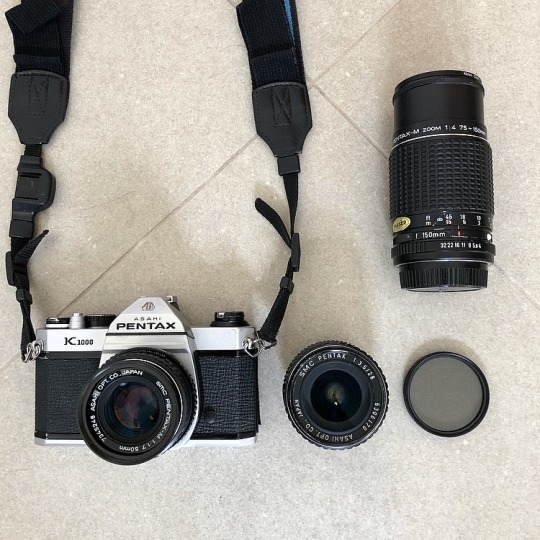
This is my main camera. It’s a Pentax K1000 from some point between 1977 and 1990. I chose this as my first camera because it’s a completely manual 35mm: you’re in charge of focus, you’re in charge of winding onto the next frame, you’re in charge of exposing the picture correctly. I didn’t have any knowledge of photography before I came to shooting on this and I knew the best way of learning is to do EVERYTHING. It’s heavy and metal and I’ve had a few lumps on the head from beaning myself with it, but it’s a solid workhorse. It just doesn’t let me down. And you can usually find a decent one on ebay between £70 and £150. 35mm in camera speak is the size of the little rolls of film you saw your parents or grandparents use back in the 80s and 90s. It’s the size of the frame that you’re putting your picture on inside the camera! 3.5cm!
What I love most about Pentax is their range of top quality lenses. The glass is SUPERB. The lens attached to the camera in the picture is a 50mm 1:1.7 - what you would usually use for street photography. The small lens next to it is my main lens - it’s what I use for all the landscape photography in Wales and Scotland etc. It’s relatively rare - a 28mm 1:3.5 lens - and cost me more than the camera (about £150), but the sharpness is BRILLIANT. The big, long lens in the picture is a 75-150mm zoom lens which I use when I’m travelling in cities. Being able to change your focal length in one lens is much easier than stopping to change lenses, but the downside is a loss of sharpness. For the most part, all zoom lens are inferior to prime (non-zoom) lenses in terms of sharpness but this one does well and only cost me about £75.
If you don’t know anything about focal length in lenses: the smaller the mm length (eg. 28mm) the wider the angle. Wide angle = good for landscape. But if you wanted to concentrate on portrait photography, you’d maybe go for a 105mm lens - this means you can keep a little distance from your subject but still have a nice, tight frame. This isn’t a hard and fast rule by the way! But it might help you decide on what lens you want to initially spend your money on.

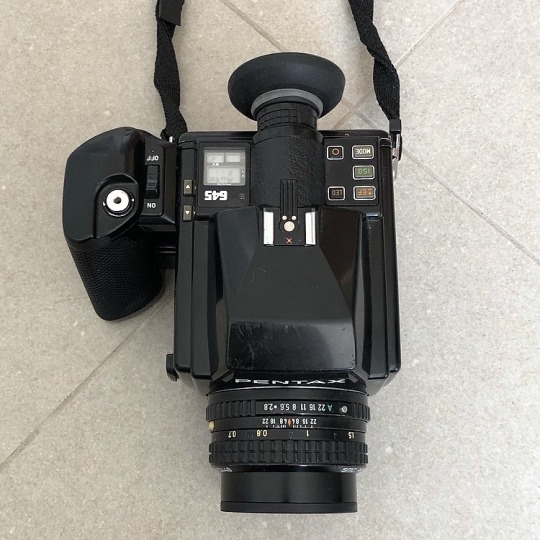
This is my BEAST. It’s so bloody heavy. This is a 120mm (also known as medium format) camera - my Pentax 645. Because the size of the film frame is larger (120mm as opposed to 35mm in the Pentax K1000 above) it’s able to capture a LOT more detail. I don’t use this a huge amount as it’s so heavy, but its so fun to use. The sound of the shutter is like gunfire. It’s NOT for street photography as there’s no way you can blend in while making such a loud sound. If you’re looking to get into 120mm photography - this is a solid choice. Or if you have the money, its fancier, sharper sister - the Pentax 67.
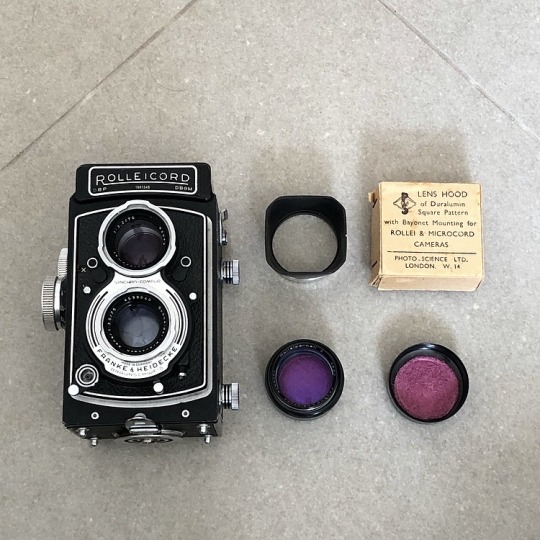

This is my baby. I love it. I love just looking at it. I love the pictures it takes. It’s a Rolleicord Vb from the 70s. For a 50 year old camera it takes the most mouthwatering photos. Like the Pentax 645 above, it’s a 120mm (medium format) camera so it uses a larger film roll than the 35mm. Whenever you see a square framed picture on this blog, THIS is the camera that took it. You can’t change the lens and you have to look DOWN into the camera while holding it at chest height. You see the image through the top lens (the top round circle) and the picture is taken on the bottom lens (the bottom round circle). It doesn’t have a light meter so I have to use an app on my phone to get the right exposure.
This camera requires some thought when taking a picture - you can’t just snap away on it - but it rewards your patience like HOOOOOOO BOYYYYYY. Go have a look through my rolleicord tag - look how beautiful some of them are, particularly the landscape ones. If it’s ever out of focus that is because of ME and my crappy eyesight.
You can see I have a lens hood and the original box for it in the top picture- this blocks stray sunlight so I can try and avoid sun glare on the images. The little purple glass lens below it is what’s called a Rolleinar. I attach this to the camera lens and it changes my focal length. So I can go from landscape to portrait without changing cameras. The Rolleicord has a fancier sister - the Rolleiflex, which again has sharper glass but it comes with a bigger price tag.
I’d really only advise going for a TLR (Twin Lens Reflex) camera like my Rolleicord once you have some solid experience of working on a manual or semi-manual 35mm camera.
This is a lot of information, I’m sorry about that anons! But if you want a good starter camera for film: go for a Pentax K1000, an Olympus OM or AE1, or a camera from the Nikon FM series. All are good, solid cameras, with a nice range of lenses for not too much money on ebay.
If there’s any more questions, just let me know :)
Sx
17 notes
·
View notes
Text
what percentage of the world’s freshwater is frozen
what percentage of the world’s freshwater is frozen
Hello dear friends, thank you for choosing us. In this post on the solsarin site, we will talk about ” what percentage of the water on earth is not frozen freshwater “.
Stay with us.
Thank you for your choice.
Ice, Snow, and Glaciers percentage world’s freshwater
The color white reflects sunlight (heat) more than darker colors, and as ice is so white, sunlight is reflected back out to the sky, which helps to create weather patterns. Read on to learn how glaciers and ice caps are part of the water cycle.
Water stored as ice is part of the water cycle frozen
The water cycle describes how water moves above, on, and through the Earth. But, in fact, much more water is “in storage” at any one time than is actually moving through the cycle. By storage, we mean water that is locked up in its present state for a relatively long period of time. Short-term storage might be days or weeks for water in a lake, but it could be thousands of years for deep groundwater storage or even longer for water at the bottom of an ice cap, such as in Greenland. In the grand scheme of things, this water is still part of the water cycle.
Ice caps around the world
Map of where glaciers and ice caps exist on Earth.
Credit: National Geographic
The white areas in this map show glaciers and ice sheets around the world (reproduced from National Geographic WORLD, February 1977, no. 18, p. 6, with permission). The vast majority, almost 90 percent, of Earth’s ice mass is in Antarctica, while the Greenland ice cap contains 10 percent of the total global ice mass.
The Greenland ice cap
The Greenland ice cap is an interesting part of the water cycle. The ice cap became so large over time (about 600,000 cubic miles (mi3) or 2.5 million cubic kilometers (km3)) because more snow fell than melted. Over the millennia, as the snow got deeper, it compressed and became ice. The ice cap averages about 5,000 feet (1,500 meters) in thickness, but can be as thick as 14,000 feet (4,300 meters). The ice is so heavy that the land below it has been pressed down into the shape of a bowl. In many places, glaciers on Greenland reach to the sea, and one estimate is that as much as 125 mi3 (517 km3) of ice “calves” into the ocean each year—one of Greenland’s contributions to the global water cycle. Ocean-bound icebergs travel with the currents, melting along the way. Some icebergs have been seen, in much smaller form, as far south as the island of Bermuda.
Ice and glaciers come and go, daily and over millennia
The climate, on a global scale, is always changing, although usually not at a rate fast enough for people to notice. There have been many warm periods, such as when the dinosaurs lived (about 100 million years ago) and many cold periods, such as the last ice age of about 18,000 years ago. , and extended well into the United States.
Glaciers are still around today; tens of thousands of them are in Alaska. Climatic factors still affect them today and during the current warmer climate, they can retreat in size at a rate easily measured on a yearly scale.
Random Posts
what percent of alcohol is in corona beer
what percent of alcohol is in heineken beer
Glacier worldwide are shrinking in size frozen
This picture shows the Grinnell Glacier in Glacier National Park, Montana, USA in 2005. The glacier has been retreating rapidly since the early 1900’s. The year markers point to the former extent of the glacier in 1850, 1937, 1968, and 1981.
Ice caps influence the weather and percentage world’s freshwater
Just because water in an ice cap or glacier is not moving does not mean that it does not have a direct effect on other aspects of the water cycle and the weather. Ice is very white, and since white reflects sunlight (and thus, heat), large ice fields can determine weather patterns. Air temperatures can be higher a mile above ice caps than at the surface, and wind patterns, which affect weather systems, can be dramatic around ice-covered landscapes.
Some glacier and ice cap facts of world’s freshwater frozen
Bering Glacier in Alaska is the largest glacier in North America. This NASA satellite view shows how a glacier is similar to a river.
(Credit: NASA Earth Observatory)
View full size
Glacial ice and world’s freshwater frozen
Glacial ice covers 10-11 percent of all land.
According to the National Snow and Ice Data Center (NSIDC), if all glaciers melted today the seas would rise about 230 feet (70 meters).
During the last ice age (when glaciers covered more land area than today) the sea level was about 400 feet (122 meters) lower than it is today. At that time, glaciers covered almost one-third of the land.
During the last warm spell, 125,000 years ago, the seas were about 18 feet (5.5 meters) higher than they are today. About three million years ago the seas could have been up to 165 feet (50.3 meters) higher.
Largest surface area of any glacier in the contiguous United States: Emmons Glacier, Washington (4.3 square miles or 11 square kilometers)
Ice caps and global water distribution
Even though the amount of water locked up in glaciers and ice caps is a small percentage of all water on (and in) the Earth, it represents a large percentage of the world’s total freshwater. As these charts and the data table show, the amount of water locked up in ice and snow is only about 1.7 percent of all water on Earth, but the majority of total freshwater on Earth, about 68.7 percent, is held in ice caps and glaciers.
Fresh water or world’s freshwater frozen
Fresh water (or freshwater) is any naturally occurring water containing low concentrations of dissolved salts and other total dissolved solids. Though the term specifically excludes seawater and brackish water, it does include non-salty mineral-rich waters such as chalybeate springs. Fresh water may include water in ice sheets, ice caps, glaciers, icebergs, bogs, ponds, lakes, rainfall, rivers, streams, and groundwater contained in underground aquifers.
Numerical definition frozen
Fresh water can be defined as water with less than 500 parts per million (ppm) of dissolved salts.[2]
Other sources give higher upper salinity limits for fresh water, e.g. 1000 ppm[3] or 3000 ppm.[4]
Sources
Main articles: Water cycle and Water resources
The original source of almost all fresh water is precipitation from the atmosphere, in the form of mist, rain and snow. Fresh water falling as mist, rain or snow contains materials dissolved from the atmosphere and material from the sea and land over which the rain bearing clouds have traveled. The precipitation leads eventually to the formation of water bodies that humans can use as sources of freshwater: ponds, lakes, rainfall, rivers, streams, and groundwater contained in underground aquifers.
resource: wikipedia
What Percentage Of Earth’s Water Is Frozen?
From space, the earth looks like a majestic blue bubble, the blue color of the earth is because of reflection of the light from the planet’s massive oceans. About 71% of the planet is covered by water while the rest is land.
Water is considered a finite source; it circulates across the oceans, land surface and underground. The bottled water we drink was once flowing in the rivers and existed in the atmosphere as water vapor before cooling a trickling down as rain.
The earth’s water frozen
The earth’s water has existed for billions of years. Researchers are yet to determine where exactly the water came from but it is theorized that it might have been carried into the earth by meteors and meteorites during the early years of the planet. No water leaves or enters the earth’s atmosphere. The hydrologic cycle cleans and replenishes the planet’s water.
0 notes
Text
Others - Chapter 5
Archive of our Own: http://archiveofourown.org/works/12611836/chapters/29092887
Wattpad: https://www.wattpad.com/496247147-others-a-jacksepticeye-fanfiction-chapter-5
Story below the cut
Schneep?
“Vhat is it?”
The scientist’s voice was quiet and trembling, like he was holding tears back.
Are you guys okay?
“A little vorse for vear but ve’re getting better.”
Don’t lie to me. You’re scared as hell. He’s up there and awake isn’t He…
No reply.
Jack sat in the white padded room, huddled in the farthest corner from the door that didn’t have a bed in it. He picked at the hem of his sleeve, bored, contemplating. What, he wasn’t entirely sure. His mind was all over the place at this point that even he wasn’t sure what he was thinking about.
Small headaches came and went as time went by and they became more of a nuisance now than a pain that started in the back of his head and migrated slowly to his temples where they ended. Except, now there was a prolonged headache in the front of his head.
How long had it been since he slept? Jack stopped counting a long time ago, when he had lost track of time entirely. He stopped counting when one certain headache was worse than the ones before. He was in so much pain at that point, he wasn’t sure how long it lasted.
He moved to lay down on his back at a 45° angle from the 90° corner, legs raised and perpendicular to the walls corresponding to either leg, staring up at the ceiling and its single light in the center of the square room.
Jack hadn’t slept. Not a wink. He physically couldn’t. He was terrified of the nightmares, even the thought of possibly letting Him take control, whether it be on purpose or by accident, was enough to make him shiver and want to cry.
By the point Megan had walked into the room, Jack had shut his eyes, not noticing the opening door or hearing her muffled steps across the padded floor, too lost in his own mind. He was breathing deeply, legs still raised and fingers twitching every now and then.
For a while, she didn’t say anything, and neither did Jack. They just sat there, Megan listening to Jack’s breathing, how it sped up and slowed down irregularly.
Finally, Jack opened his eyes. His face held no reaction when he spotted her sitting on his bed, probably about three meters away from him. He had had the feeling like he wasn’t alone for the past ten minutes.
“Go on. Say it. I’m crazy.” he droned, shifting his vision so he made eye-contact with her.
She didn’t reply for a few moments.
“What the hell were you talking about before?”
His lips curled back slightly, hinting at a snarl. “You know what the fuck I was talking about. You talked about Him.”
“I was talking about Jackson before. I have no clue what you were talking about.”
The news hit him in the face like a truck. No, not any old truck, and it wasn’t even one. It was three semi-trucks heading straight for his face and SMACK. There’s the newspaper, the front page reading “Jack Fucked Up Big Time” of the newspaper “SepticEye Weekly.”
Jack covered his face with his hands, letting out a silent, breathy groan. He sat up cross-legged and pressed the top of his head into the corner he was now facing, listening.
Silence. Endless silence. The terrifying quiet that never occurred. He couldn’t hear a damn thing except for Megan trying to speak to him.
“-to help you. Jack, are you listening?”
Jack didn’t respond. He was afraid to. He didn’t want to give away any more information accidentally.
“I want to help you, but I can’t if yo-”
“It’s quiet…”
Megan paused, probably processing what Jack said. “W-... What?”
“It’s quiet. It’s never quiet. There’s always someone talking up in me noggin.” His irish accent stood out more. Out of sight of the doctor, Jack smiled and almost chuckled, his body shook but no noise came out. His smile disappeared before he stood up and turned to her.
“I’m fine. I haven’t passed out, I’m not a danger to anyone.”
Megan twisted her head away from him skeptically. “Are you sure… because this guy you keep talking about seems like he really scares you.”
Jack gulped, thinking for an answer. “He’s not here and hasn’t been here for years. There’s nothing to worry about.”
“Well, I’ll leave it up to the other doctors. I’ll talk to them about getting you out of here and to your room.”
With that Megan left Jack alone in his room.
There was a small whimper in his head. Probably Chase.
Jack lay on his bed in his room again, away from the white padded room. The desk, chair, bed, even the pencils on the desk seemed to have not moved at all. But to him, it seemed totally foreign. Maybe that’s because he’s been away from the room for so long.
He wasn’t allowed to leave his room quite yet. Breakfast had started already, but another doctor wanted to do and analysis of him before he joined gen pop again. Jack didn’t know when until the man opened the door.
He wore the blue scrubs like Megan did and his white coat looked like it was a bit too big for him. He looked to be in his mid-30s, bags under his eyes showed that he had been here all night. He was probably going to go home after this. He had dull blue eyes that looked brown compared to Jack’s bright blue. He was wearing green sneakers that went surprisingly well with his shoulder-length brunette hair.
“Hello, I’m Doctor Quinn.”
“Wassup Doc?”
Dr. Quinn gave him a knowing look, but didn’t seem amused. He pulled the chair from the desk and sat down, looking over the paper he had clipped to his clipboard with his pen lightly pressed to his teeth.
Ugh, this guy’s lame.
No response. Still not normal.
“Headaches?”
“Gone.”
“Arms?”
“A little sore.”
He scribbled on his clipboard for a few seconds.
“Voices?”
“Silent.”
He looked up from the clipboard for a moment before Jack added, “Other than the occasional whine.”
Dr. Quinn let out an annoyed sigh before scribbling on his clipboard more. He stood up and gestured for Jack to follow him.
They made their way to the cafeteria where everybody was.
For a moment, a smirk was placed on his lips. But it was pulled away immediately.
#jacksepticeye#antisepticeye#chase brody#dr schneeplestein#jackieboy man#marvin the magnificent#jackson daniels#dappersepticeye#My Stories#fanfiction#Others#back to normal right...?#*hides in corner while sipping a cup of tea*
1 note
·
View note
Text
Day 8, April 14, 2019: Hoi An Eco Tour and Da Lat
Unfortunately due to some flight changes on the part of Vietnam air, our original plan of a late flight to Da Lat was moved up to the afternoon. While this decreases our time in Hoi An, it did not prevent us from completing the Hoi An area Eco Tour, a piece of the Vietnam trip my grandmother really enjoyed when she visited last year.
Our tour guide from Jack Tran Tours was Viet and he greeted us with a smile and sense of humor bright and early at 7am. He took us on a short van ride to our beach cruiser bikes for the day. We hopped on and peddled out of the main city past rice paddies and new highways. Our first stop on the tour was a home belonging to three women in their early 60s: 61, 62. 63. One was widowed young when her husband died of a moto incident at 24. Another had a son. This is likely the one who also has a grandson who just turned one. Birthday decorations remain outside from the previous evening.The last woman never married. The three live together in a very basic home. They sleep on what westerners would call a rather antiquated bed, without a proper mattress. In addition to getting paid for hosting tourists like us, these woman make money by farming and selling their crops at the local market.They wake up at 2am to begin to water their crops, which they do by hand except for when it’s really really hot. These women have about 700 square meters and they grow mustard seeds (which take a week) as well as onions. Morning glory, lemon basil and more. Many of these plants require growing and then transplanting over to a new part of the farm for replanting. They fertile the soil with seaweed from a nearby fish farm, as well as cow or water buffalo dung. Two of the women are home when we visit. The oldest is 63 but looks far older. She is permanently hunched over—a direct result of her watering the garden which she can no longer do. That doesn’t stop her, she is still hustling about. A younger one is working and watering and urges us to take a try at watering and then planting. She too is slight and looks older than she is. Some of her teeth are missing, but that doesn’t stop her from smiling. Before departing she hands us a bag of fresh herbs and lettuce for our upcoming lunch. Talk about organic growers. 220 families around these parts once grew food for a living. Today, about 130 continue to farm and 90 or so have moved to work in the tourism industry. Farming is not a particularly lucrative trade. Despite being expert exporters of rice, just growing rice is a hard salary to live off. A 49 hectare dawn may yield one crop after three months. These 3 months earn the family less that what they can live on. After all a farm this big might yield 400kg in seed but after shelling, only 280kg of rice. If we assume 1 dollar = 2kg, for three months work and a whole harvest, only $150 might be yielded from this harvest. Most people supplement this farming income with other crops tourism etc. the Mekong delta which we’ll visit later this week is the largest and main exporter of rice in Vietnam. Unlike here they can harvest not two, but three crops of rice per year.
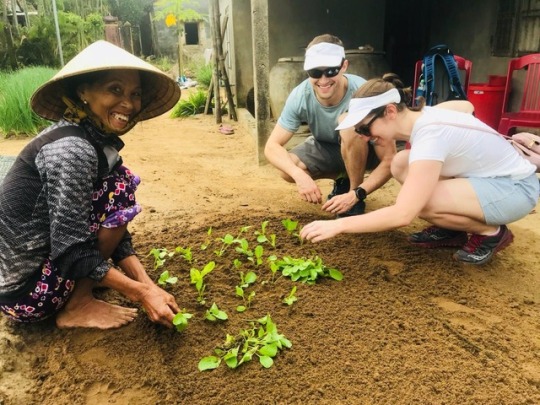

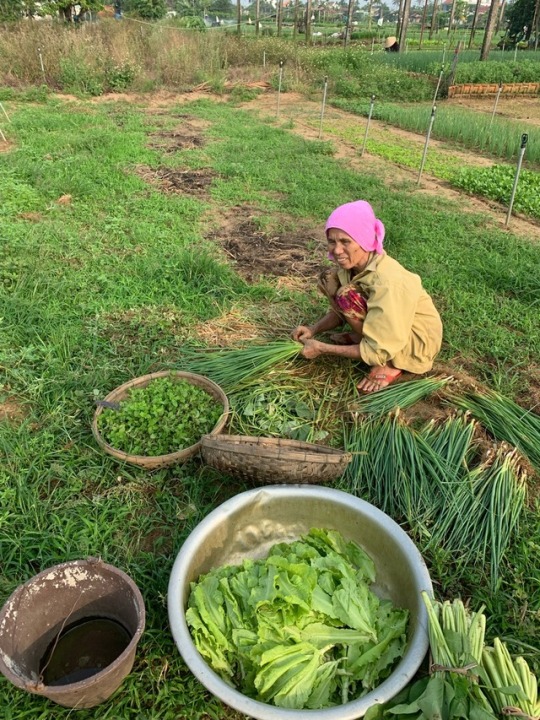
We get back on our bikes and cycle past a number of shrimp farms, and of course more rice paddies. Near to a large traffic circle and the highway we dismount once again for the most touristy part of the trip—water buffalo riding. This is when I learn that the only animal Kerran has ever ridden is a camel! The coolest part about this stop is actually the nearby brown cow (they don’t have black and white ones here) and the day old calf following it around as it learns to walk. After our carnival-like bull riding experience we get back on our bikes and cycle toward the river. We pass the countless beach side hotels and wave hello to the ocean. Like Danang, more resorts are popping up often. Our guide Viet’s wife works part time in one hotel doing laundry, but not for the next six months as she had their first child six days ago!
On the river side, we board a boat and take off our shoes as instructed. We are in Coco River, names for the long necked bird (is egret) that you can see everywhere. Coconut cake and sliced pineapple await us for a morning snack. We begin sailing away from land toward the open bay. Our first stop is a small fishing boat. A jolly woman rows from the back while a man throws a net out repeatedly. The net is beautiful as it’s tossed. We board their boat and see that they’ve just caught one small fish. Kerran tries and does well on his first try. I kind of suck at it. We don’t catch anything but the experience is cool. Admittedly this is pretty late in the AM for this.
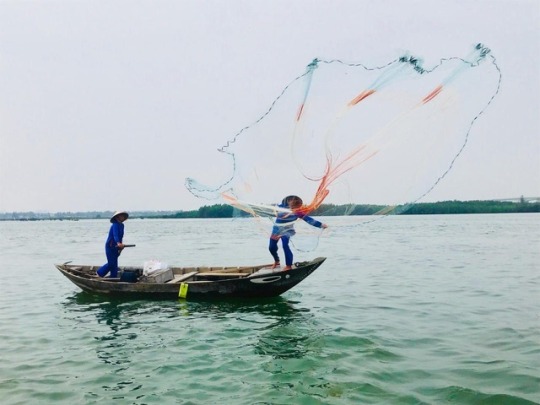
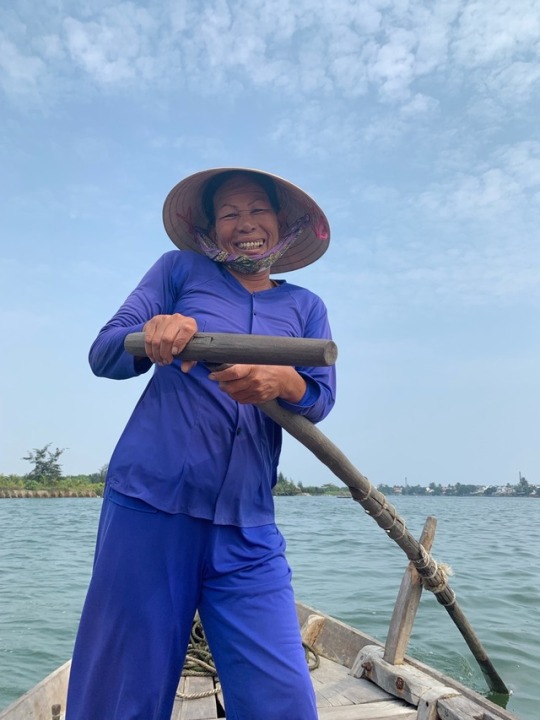
We get back on our bigger boat and sail on. We pass the fishing village of a Cua Dai (another name for the river) where Viet grew up. This is a village with about 5000 people. In 2000 about 90% of people worked in fishing. Today, only 40% work in fishing and the majority of others have moved to tourism. Viet is one of five kids—his brother is in construction but all three sisters work in hotels as chambermaids, doing laundry etc. All of the girls stopped school at age 12 while the boys continued. Today however schooling is compulsory for both genders until age 18. Similar to our first guide, Viet got electricity in 1993. He remembers the whole village circling around the two televisions in 1998 to watch a soccer match. In 1999 UNESCO names Hoi An a historic world heritage site. Tourism has been growing exponentially ever since. In 2017 Hoi An saw and estimated 2.5M tourists. Last year there were 3.8M. There are 150,000 people living in Hoi An! Viet thinks about 70% are from China and Korea, and this is less good as most reside in Chinese owned hotels in nearby Danang.
We sail onward toward the water coconut forests. These plants aren’t endemic to the area and are originally from the Mekong delta and used to help prevent erosion. The coconut forest was also a hiding place for about 140 Vietnamese during the American war. Only about 40 survived, half of which were heavily injured. In this place about 1000 people died, including the Vietnamese soldiers, Americans and locals. In wet season they hid right in the water eating fish and the oysters that dot the palm trunks. In dry season they covered themselves with mud to camouflage themselves from the Americans. Today it’s a beautiful area (well, the parts that aren’t littered with trash). The crew of our own boat demonstrated how to use circular basket boats made of bamboo. They are waterproofed with tar and cow dung. The Vietnamese originally created these (based on a Welsh boat) because the french taxes the length of boats and this significantly decreased the cost. Today they cost about 200-250 US dollars. The staff do a demonstration, cheekily singing Gangnam style as they go. Then we get in and it feels as if we’re on a tilt a whirl. After this bit of touristy and somewhat gimmicky fun, Viet also boards the boat and we sail through the forest. We pick up garbage as we go and eventually reach an area without too much litter. Both Viet and the boat rower start using palm leaves to create some very impressive origami. He also constructs two fishing rods and baits them with an oyster from the palm leaves. We are going fishing for crabs. Kerran lures the crab in with his bait and we scoop the black crabs with purple pinchers into what looks like a leftover gasoline or washing detergent canister. We catch a few but they are all quite small so we ultimately let them go.
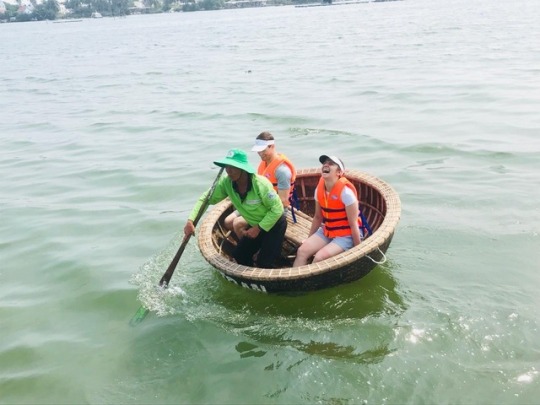
We then board the big boat again and head toward our last stop to try another type of fishing. Nearby the beach we board the small basket boat once again to get to shore. On shore is a large contraption used for reeling in a giant net. Typically these fisherman are out from 5pm to 3am but our host is up and about for us. He’s heavily tanned from being in the sun and has use only of one arm and yet he manages to reel in this heavy thing. The large net has holes in very strategic places and he strategically moves the net to get out the fish. This morning we catch nothing but small babies so we let those go.

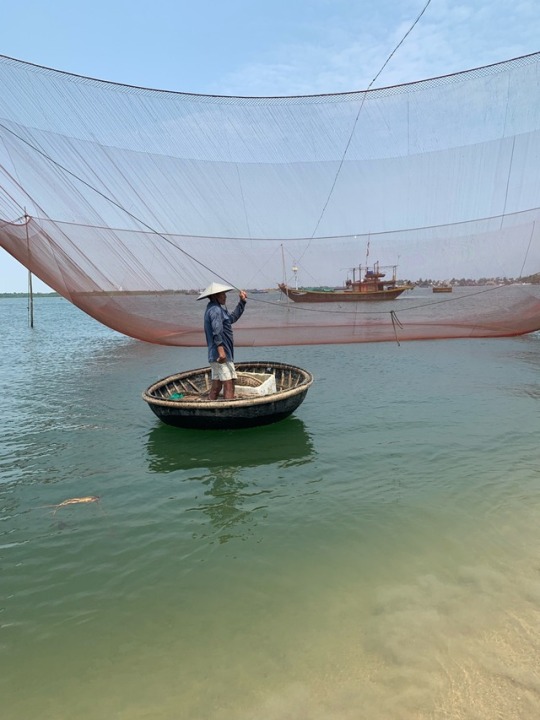
Back on board the bigger boat the crew is making us lunch. As always with these touristy things, there is more food than we can handle. We start with spring rolls, then get a calimari salad, grilled mackerel, tons of rice, traditional morning glory and the pancake spring rolls I had last night. Dessert is mung bean cookies. I am completely stuffed. We sail back to shore and Viet boards a small van with us back to our hotel. The driver could be a NYC cab driver—he’s a bit aggressive and swerved around tour busses. I am genuinely fearful for the motorbikes on the road!
We’re back to the hotel in time to freshen up before Hoai picks us up at 1:25pm to take us to the airport. We bid farewell to Hoai and take the one hour flight to the mountain region of Da Lat.
Boy are we glad when we get here. It’s cool!!! Our guide, who insists we call him Frankie, meets us at the airport. He’s clearly more outdoorsy than the other guides, and much younger, just a few years older than we are. He studied law and English at university but after a year of attempting to practice law in Saigon after university, he was itching to come back and become a guide. He says his mom was not thrilled! He has both a ten year old and 1 year old girl.
We check in at the Dalat Palace Hotel, originally built by the french and finished in 1922. It has all the charms of a historic hotel but admittedly, is in need of a bit of a renovation.
We freshen up and meander into town where a bustling night market takes place. This weekend is also a holiday weekend so Vietnamese tourists are everywhere. The night market here is less touristy and more authentic-people selling warm weather clothes and countless foods. You can easily identify the Vietnamese tourists because they are dressed in hats and scarves. It’s probably about 65 degrees.
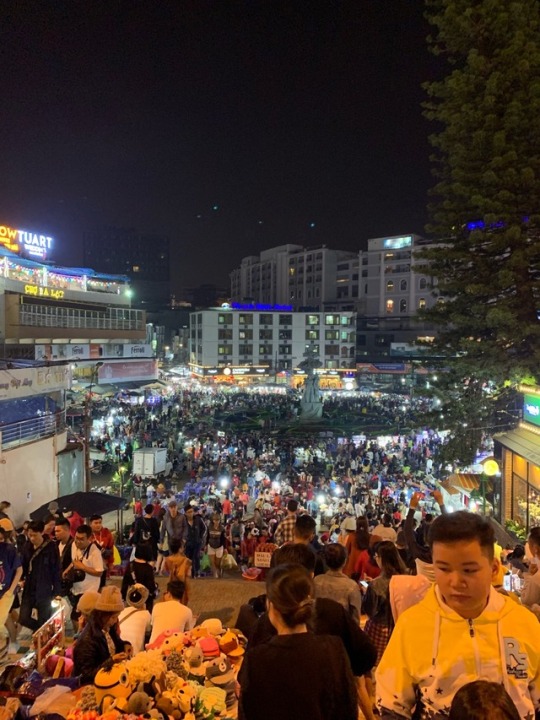
We eat a bit off the main drag at a small restaurant called Trong Dong. When we arrive we’re the only ones there but a few other couples wander in. There are only about 7 or 8 tables here—each covered with a plaid table cloth that is then layered with a white one. It’s quiet and cute with an extensive menu of Vietnamese food. We learn at this dinner that Da Lat produces wine (it’s okay). I get a delicious clay pot of spicy pork.

We’re exhausted after dinner and meander our way back through the night market toward tour hotel which is perched on a hill and overlooks the towns lake. We stop to take pictures of an impromptu dance session and the boards of people eating and enjoying the market. This city is funky—it’s both beautifully adorned with flowers (earning it its name of the flower city) and also somewhat kitschy with lights all around. We’re ready to explore!
0 notes
Text
Africa Roundup: Paga goes global and 4 startups raise $99M in VC
Jake Bright Contributor
Jake Bright is a writer and author in New York City. He is co-author of The Next Africa.
More posts by this contributor
Polestar unveils first production EV with aim to overtake Tesla
Liquid Telecom goes long on Africa’s startups as future clients
Nigerian digital payments startup Paga is gearing up for international expansion with a $10 million round led by the Global Innovation Fund.
The company is exploring the release of its payments product in Ethiopia, Mexico, and the Philippines—CEO Tayo Oviosu told TechCrunch.
Paga looks to go head to head with regional and global payment players, such as PayPal, Alipay, and Safaricom according to Oviosu.
“We are not only in a position to compete with them, we’re going beyond them,” he said of Kenya’s MPesa mobile money product. “Our goal is to build a global payment ecosystem across many emerging markets.”
Launched in 2012, Paga has created a multi-channel network and platform to transfer money, pay bills, and buy things digitally 9 million customers in Nigeria—including 6000 businesses.
Since inception, the startup has processed 57 million transactions worth $3.6 billion, according to Oviosu. He joined Cellulant CEO Ken Njoroge and Helios Investment Partners’ Fope Adelowo at Disrupt San Francisco to discuss fintech and Africa’s tech ecosystem.
youtube
South African fintech startup Jumo raised a $52 million round (led by Goldman Sachs) to bring its fintech services to Asia. The company—that offers loans to the unbanked in Africa—has opened an office in Singapore to lead the way.
The new round takes Jumo to $90 million raised from investors and also saw participation from existing backers that include Proparco — which is attached to the French Development Agency — Finnfund, Vostok Emerging Finance, Gemcorp Capital, and LeapFrog Investments.
Launched in 2014, Jumo specializes in social impact financial products. That means loans and saving options for those who sit outside of the existing banking system, and particularly small businesses.
To date, it claims to have helped nine million consumers across its six markets in Africa and originated over $700 million in loans. The company, which has some 350 staff across 10 offices in Africa, Europe and Asia, was part of Google’s Launchpad accelerator last year. Jumo is led by CEO Andrew Watkins-Ball, who has close to two decades in finance and investing.
Lagos based Paystack raised an $8 million Series A round led by Stripe.
In Nigeria the company’s payment API integrates with tens of thousands of businesses, and in two years it has grown to process 15 percent of all online payments.
In 2016, Paystack became the first startup from Nigeria to enter Y Combinator, and the incubator is doing some follow-on investing in this round.
Other strategic investors in this Series A include Visa and the Chinese online giant Tencent, parent of WeChat and a plethora of other services. Tencent also invested in Paystack’s previous round: the startup has raised $10 million to date.
Paystack integrates a wide range of payment options (wire transfers, cards, and mobile) that Nigerians (and soon, those in other countries in Africa) use both to accept and make payments. There’s more about the company’s platform and strategy in this TechCrunch feature.
South African startup Yoco raised $16 million in a new round of funding to expand its payment management and audit services for small and medium-sized businesses as it angles to become one of Africa’s billion-dollar businesses.
To get there the company that “builds tools and services to help SMEs get paid and manage their business” plans to tap $20 billion in commercial activity that the company’s co-founder and chief executive, Katlego Maphai estimates is waiting to move from cash payments to digital offerings.
Yoco offers a point of sale card reader that links to its proprietary payment and performance software at an entry cost of just over $100.
With this kit, cash-based businesses can start accepting cards and tracking metrics such as top-selling products, peak sales periods, and inventory flows.
Yoco has positioned itself as a missing link to “solving an access problem” for SMEs. Though South Africa has POS and business enterprise providers — and relatively high card (75 percent) and mobile penetration (68 percent) — the company estimates only 7 percent of South African businesses accept cards.
Yoco says it is already processing $280 million in annualized payment volume for just under 30,000 businesses.
The startup generates revenue through margins on hardware and software sales and fees of 2.95 percent per transaction on its POS devices.
Yoco will use the $16 million round on product and platform development, growing its distribution channels, and acquiring new talent.
Emerging markets credit startup Mines.io closed a $13 million Series A round led by The Rise Fund, and looks to expand in South America and Asia.
Mines provides business to consumer (B2C) “credit-as-a-service” products to large firms.
“We’re a technology company that facilitates local institutions — banks, mobile operators, retailers — to offer credit to their customers,” Mines CEO and co-founder Ekechi Nwokah told TechCrunch.
Most of Mines’ partnerships entail white-label lending products offered on mobile phones, including non-smart USSD devices.
With offices in San Mateo and Lagos, Mines uses big-data (extracted primarily from mobile users) and proprietary risk algorithms “to enable lending decisions,” Nwokah explained.
Mines started operations in Nigeria and counts payment processor Interswitch and mobile operator Airtel as current partners. In addition to talent acquisition, the startup plans to use the Series A to expand its credit-as-a-service products into new markets in South America and Southeast Asia “in the next few months,” according to its CEO.
Nwokah wouldn’t name specific countries for the startup’s pending South America and Southeast Asia expansion, but believes “this technology is scalable across geographies.”
As part of the Series A, Yemi Lalude from TPG Growth (founder of The Rise Fund) will join Mines’ board of directors.
Digital infrastructure company Liquid Telecom is betting big on African startups by rolling out multiple sponsorships and free internet across key access points to the continent’s tech entrepreneurs.
The Econet Wireless subsidiary is also partnering with local and global players like Afrilabs and Microsoft to create a cross-border commercial network for the continent’s startup community.
“We believe startups will be key employers in Africa’s future economy. They’re also our future customers,” Liquid Telecom’s Head of Innovation Partnerships Oswald Jumira told TechCrunch.
With 13 offices on the continent, Liquid Telecom’s core business is building the infrastructure for all things digital in Africa.
The company provides voice, high-speed internet, and IP services at the carrier, enterprise, and retail level across Eastern, Central, and Southern Africa. It operates data centers in Nairobi and Johannesburg with 6,800 square meters of rack space.
Liquid Telecom has built a 50,000 kilometer fiber network, from Cape Town to Nairobi and this year switched on the Cape to Cairo initiative—a land-based fiber link from South Africa to Egypt.
Though startups don’t provide an immediate revenue windfall, the company is betting they will as future enterprise clients.
“Step one…in supporting startups has been….supporting co-working spaces and events with sponsorships and free internet,” Liquid Telecom CTO Ben Roberts told TechCrunch. “Step two is helping startups to adopt…business services.”
Liquid Telecom provides free internet to 30 hubs in seven countries and is active sponsoring startup related events.
On the infrastructure side, it’s developing commercial services for startups to plug into.
“At the early stage and middle stage, we’re offering startups connectivity, skills development, and access to capital through the hubs,” said Liquid Telecom’s Oswald Jumira.
“When they reach the more mature level, we’re focused on how we can scale them up…and be a go to market partner for them. To do that they’ll need to leverage…cloud services.”
Microsoft and Liquid Telecom announced a partnership in 2017 to offer cloud services such as Microsoft’s Azure, Dynamics 365, and Office 365 to select startups through free credits—and connected to comp packages of Liquid Telecom product offerings.
On the venture side, Liquid Telecom doesn’t have a fund but that could be in the cards.
“We haven’t yet started investing in startups, but I’d like to see that we do,” said chief technology officer Ben Roberts. “That can be the next move onwards… from having successful business partnerships.”
And finally, tickets are now available here for Startup Battlefield Africa in Lagos this December. The first two speakers were also announced, TLcom Capital senior partner and former minister of communication technology for Nigeria Omobola Johnson and Singularity Investment’s Lexi Novitske will discuss keys to investing across Africa’s startup landscape.
More Africa Related Stories @TechCrunch
African Experiments With Drone Technologies Could Leapfrog Decades of Infrastructure Neglect
Fibre Wants to Make It Easier to Invest in Real Estate in Africa
Expanding its Internet Service to More Countries in Africa, Tizeti raises $3 million
Facebook Expands Its Express Wi-Fi Program for Developing Markets via Hardware Partnerships
African Tech Around the Net
Naspers’ OLX Invests $94 Million in South Africa’s Webuycars
Alibaba’s Jack Ma launches $10m Netpreneur Prize for African entrepreneurs
Sub-Saharan Africa to Hit 634 Million Unique Mobile Subscribers by 2025
MEST Invests $700k in 7 African Tech Startups
Hello Tractor, John Deere Partner to Deploy 10,000 Tractors Across Nigeria
Blockchain Startup Wala Wins 2018 Zambezi Prize for Innovation in Financial Inclusion
1 note
·
View note
Text
Week 5.5 of 2018 😢 / BKK DAY 1 🍗
Quick update on the past 3 days before I can get into bkk updates hehehe I’m calling this week 5.5 😂
Workload started piling up on Monday, but I expected it although I didn’t think it would get that insane.

Alexandra food village’s dry ban mian with J and Qien for dinner that day 🙃 Had a side of 10 gyozas cos jer said it was nice. Gyozas were good, just that 3 is my max hahaha
Oh yes, I have to mention that the auntie making my teh ice was so precise that she was using a weighing machine to weigh every single ingredient she added into the drink 😂😂 The drink turned out nice so I guess it was worth her effort? lololol
Took a bus then train back, and while we were on the train, J suddenly said “wah so fast potong pasir already!” Literally 1sec later the train announcement came “Next station, clarke quay” LOLOLOL WE LAUGHED UNTIL 😂😂😂

Skipped chiro on tues cos I couldn’t afford to leave work half an hour earlier. Met J for dinner and dk how we decided on 4 fingers haha maybe the only fried chicken I willingly eat 👌🏻 I’ll try the spicy ones next time hehe

Quickly went home to get started on packing. I only managed clothes before I turned in for the night but it was a good call to start a day early cos Wed was SHIT 😭
Told J that I was nervous for the meeting on Wed and I was right to be nervous. It went pretty badly and the amount of work to be done after the meeting........ Couldn’t help but feel like my bkk trip came at a wrong time.

Had a quick lunch of dry ban mian at vivo (I see a pattern too lolol) before we headed back to office, where I spent the rest of the work day going through an insane number of files FML

As if I didn’t have enough on my plate already, my period decided to come a couple days early 😭😭😭 I was praying it would come after the trip. Oh well, I am at least grateful it didn’t come halfway ya? Popped a panadol before I headed back to files I CRY. MY DOG LIFE
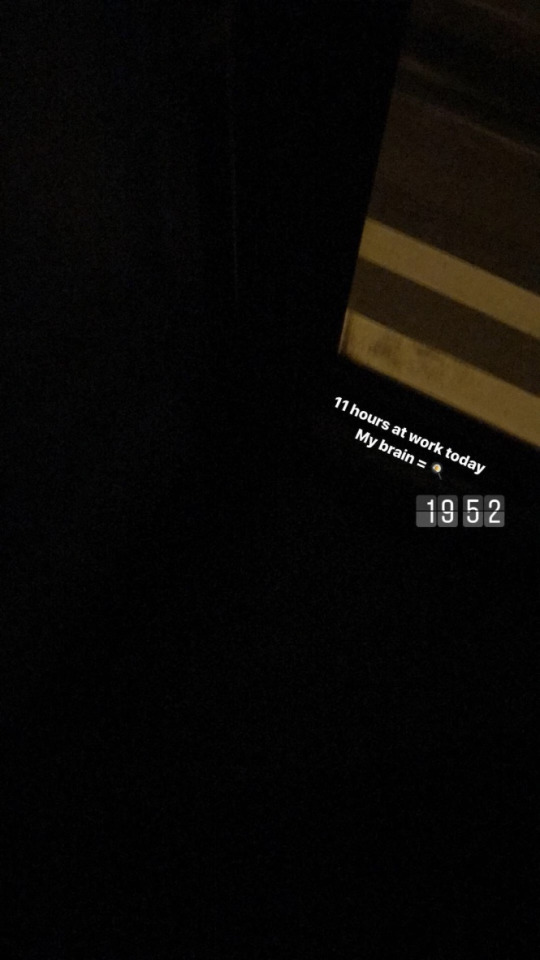
Did what I could and left office with my boss after 11 hours of the grind. Through shit like this, I am eternally grateful for a nice boss ✨
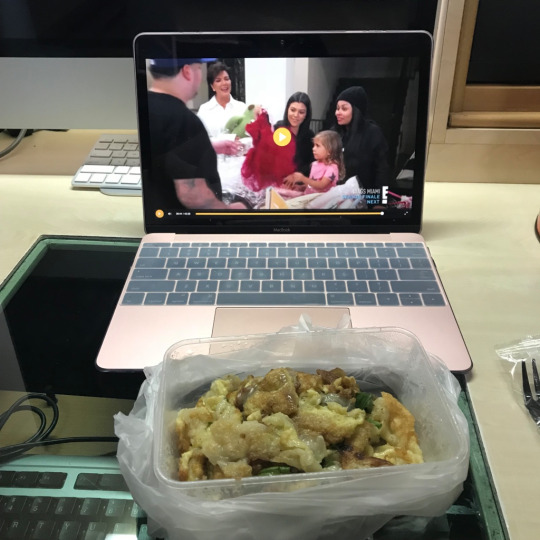
Wanted to cry when I realised there was no food at home but I sucked it up and called my mum to takeaway some food for me. I had to wait maybe an hour but I took the opportunity to chill a little cos I could feel myself being very panicky. Mum came back with oyster omelette, which I enjoyed with KUWTK 😌

And then it was time to pack.........
I didn’t leave much time for myself evidently, so I only got to bed around 1am? Holy, that’s 3 hours of packing wtf ray how????????
BKK DAY 1 🇹🇭

Tore myself out of bed at 6:15 in the morning cos I still had last minute packing to do plus this was the first time I had to call a cab to the airport myself 😅 Usually my parents fetch me there or they’re the ones calling a cab when we travel tgt haha so I was understandably a little panicky cos there were so many unknowns!!!!

Didn’t have to worry myself that much cos I got a cab easily (fare was $30 though wtfff) and reached the airport with a lot of time to spare.

Checked in and this was our first stop....
We made plans to check out the YSL outlet here, to see if the wallet I liked was cheaper since duty free and all?
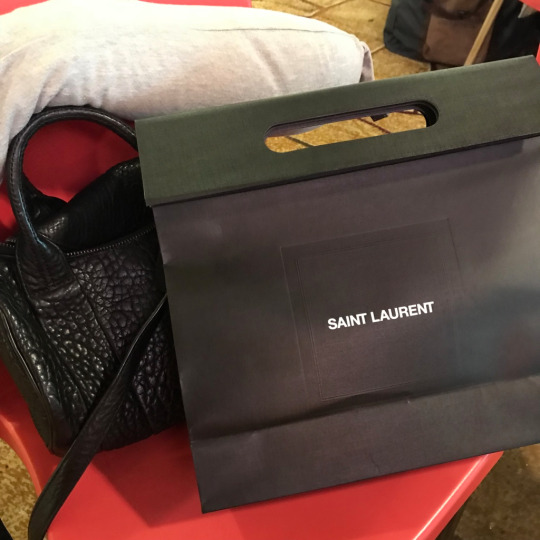
WE BOUGHT IT 😍😍😍
I was 90% decided that I really wanted the wallet already so when it was $60 cheaper than retail stores, I pretty much handed my card over immediately hahahaha I am so happy ✨✨✨ J says she wants to get it for me as a christmas cum birthday gift but we’ll see!

Yakun for breakfast, where they forced us to get large cups of drinks so obv I couldn’t finish???
Oh yes, the two evian bottles were from the YSL sales assistant haha went back to return a bottle afterwards cos it was unopened.

While waiting for J ✨

我的头发很乱

Boarded! HAHA I LUV THE HOOD omg 😂😂😂 So kewt and I even managed some sleep on the plane, which is gr8 considering the flight’s only 2 hours ✈️

我爱我的鞋子👟
Asked my mum to look at my new shoes and she said “you bought new shoes again???? Ray, when you go bkk, you just eat, don’t buy clothes and shoes ok. Just eat” LOLOL I replied with “good joke mum”
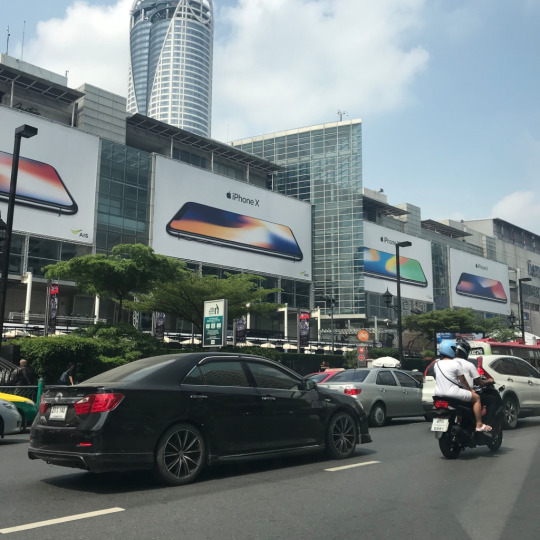
Landed, settled sim card and hopped on a cab to our hotel! The ride took ages due to the jam, and J scared me cos she told me there was no meter in the cab??? She still said “hope we don’t have to fight about the fare later” 😂😂 I also quickly went to check my past dayre post and gathered that the fare should be roughly 600baht.
Turns out meter was on all the while haha and the driver only charged us 500 phew no fight phew phew
We booked berkeley again cos it was a pretty good deal and we’re so familiar with the hotel/it’s location. Paid for late check out on monday as well since our flight’s only at 6pm. Spent a long time in our room waiting for my phone to charge 🙄 But I took the opp to quickly unpack everything.

Before we left the hotel!

J was starving by then so we stopped by mr shake at central world. My milk tea was pretty good but the calamansi drink she wanted wasn’t in stock so she ended up with plum green tea which wasn’t nice 😅
Continued with our walk to siam! I love how familiar we are with everything, such that we rmb how to walk everywhere without the need to google map 👌🏻👌🏻 J was asking me if I knew where inter was, and I said “ya just go to siam square, cut through the tiny stores then exit, cross the pedestrian crossing with the police and turn left” WHERE DID THIS INFO COME FROM????? IDK

First food stop: Inter! I think this is J’s and my favourite restaurant in bkk. The food is v good and inexpensive, what more can you ask for?
Got the water mimosa again but asked for it to be less spicy cos my dayre reminded me that it was too spicy for us the last time we were here haha tried a new fried fish which turned out pretty good surprisingly! Erm the curry beef was a mistake on my part haha I wanted to order red curry with beef but idk why it became this dish instead 😂
Curry was great but there were a lot of fatty beef parts so overall, a no go for us 🙅🏻♀️

STAR OF THE SHOW ⭐️ Couldn’t go to inter without ordering our fav wings!!!!! Still as good as before omg
Bill came up to less than $25 I LUV BKK

Shopped around siam square and exercised tremendous self control. Only bought myself a phone cover for $6 hehe proud proud
Continued wandering around the area then stopped by watsons and bath and body works to get our bkk essentials - large packet of tissue and hand sanitizer LOLOL
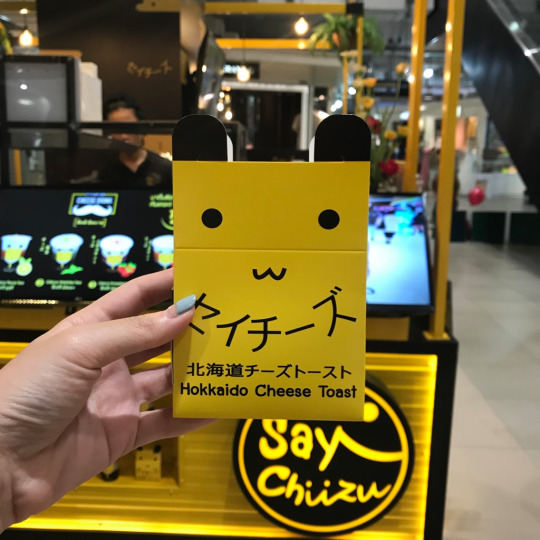
📍Hokkaido Cheese Toast @ Siam Square
Before we came to bkk, I was telling J that the cheese toast originated from here so we should eat the one here haha forgot all about it until we changed upon it at siam! Best things is there wasn’t a queue at all hehe and they had the strawberry & matcha flavours that I think aren’t out yet in singapore?
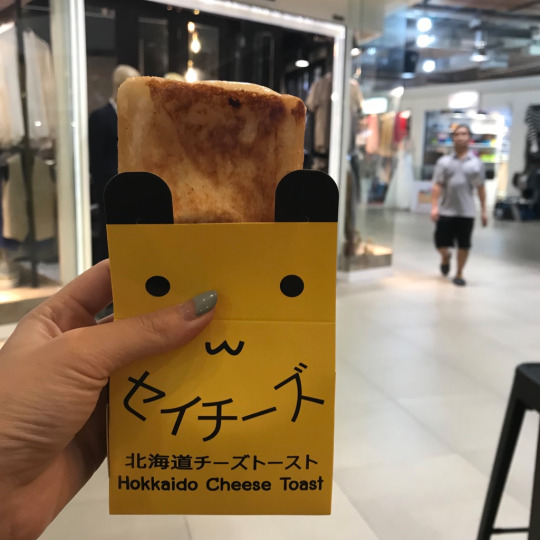
But we’re basic af, so we just got an original to share amongst the both of us! Smart decision to share cos it got a bit too much towards the end. Dk how much it is in singapore but it’s 69baht here!

🧀🧀🧀
Verdict: I quite liked it! The bread was nicely toasted and the cheese was really stretchy, not too heavy tasting. There was this creamy liquid filling inside which I didn’t like, and which is why I said it got too much towards the end haha might not eat this again, but glad I tried.
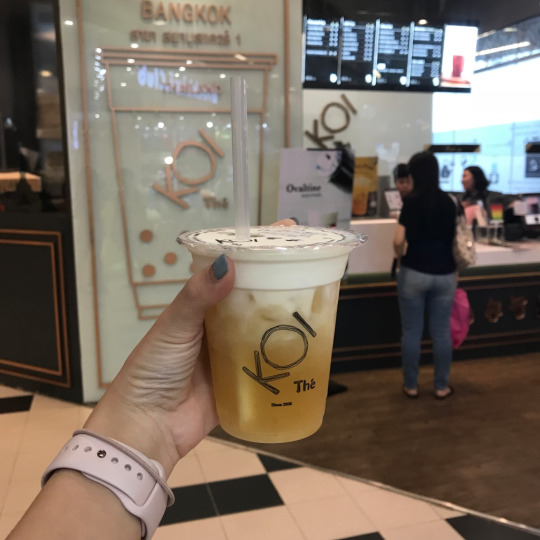
Got a bit thirsty while walking around and went in search of their koi outlet. Found it and was so pleasantly surprised that they had small sizes!!! How cute is this small green tea macchiato omg the lady helps to poke the straw in and she makes sure the straw goes through the O in KOI hahahaha i luv it they are so cute

Aesthetics 101 with this random cafe on the middle of the mall 🌿
There’s really nothing much in siam leh. I think I said this last year already hahaha plus the malls are quite confusing so we end up at the same place after walking for ages. Decided to head back to our hotel after a bit and J suggested we take a train from siam to chit lom, which is just a stop.
Not smart cos the train station was a bit confusing to manoeuvre around plus we hit peak hour I think. And it was only after we alighted at chit lom did we realise that our hotel’s in the middle between siam and chit lom haha so it would have been smarter to just walk from siam. Oh well, you learn new things everyday!

Was supposed to have after you but we were craving salty food so we headed to the hotel to rest before dinner at talad neon.
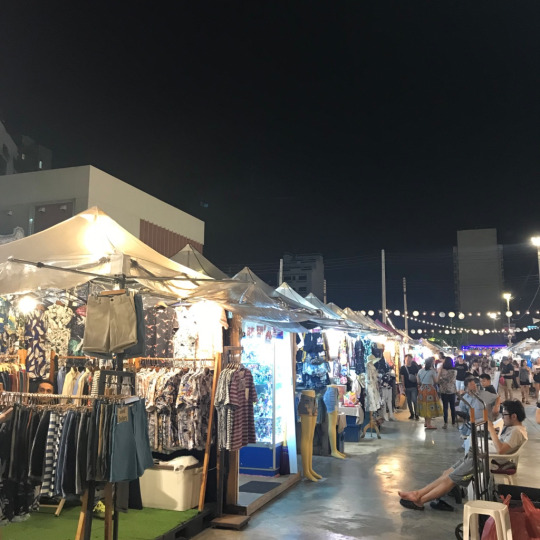
Took us a while to get out of the room haha talad neon’s super super near to our hotel which is great cos my poor feet 😅 J got a coconut drink and we walked around a bit. I love talad neon leh!!! But I can understand when people say there’s nothing much to do here. I just like it for its cleanliness, close proximity to our hotel and there’re still a decent number of shops 👌🏻

Took such a nice photo of J ✨✨
Dinner at hubba shrimps, essentially a cheaper version of dancing crab haha vibes were...... thai disco-ish 😂😂

Hello it’s me 😌
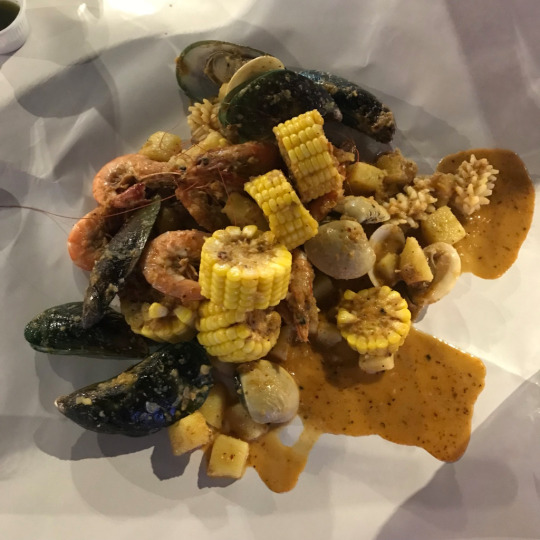
📍Hubba Shrimps @ Talad Neon
Got the one with mixed seafood, which contained shrimps, two different kinds of mussels, squid, clams, corn and potatoes. Asked for the sauce to be less spicy but less spicy in thailand doesn’t mean much lolol the sauce was v tasty though!! But the seafood was okay only, not very fresh/tasty. Overall a decent meal for less than 500 baht

💕
Continued walking around for a bit before heading back to our hotel to walk around the night market downstairs. Got myself only 2 pieces of clothing that day 😌

Yet another wrap dress from talad neon for 250 baht. As expected, it’s too big on me but I’ll make it work by looping the waist bands around my waist to give the dress some shape. It’s a little sheer as well so will have to put on an inner lining. Otherwise, I do like the cut and prints 🌾

This mustard top from the night market below our hotel for 150baht. I hesitated a little cos bkk tops are usually too huge for me, but...

it’s a tie back so you can adjust it to be smaller! I’ve been meaning to get smth like this from taobao, like it’s literally been sitting in my cart for ages haha
0 notes
Text
Video: A Deep Dive Into the World’s Oceans
In the battle for mind-share, space vs. sea is no contest.
From the epic race to reach the surface of the moon, to the well-documented trials and tribulations of SpaceX’s rocket launches, space is widely regarded as mankind’s natural next step.
For centuries, we’ve gazed at the night sky attempting to decode the messages of the cosmos, but we’ve treated the ocean as a dumping ground or as a nemesis. In the era of big data, it’s strange to note that an estimated 95% of the world’s oceans still remain unexplored.
A Deep Dive Into the World’s Oceans
Today’s video, from Tech Insider, helps shed some light on just how deep the ocean is, and put that depth into a context us surface-dwellers can understand.
youtube
The ocean is vast, but looking at it in terms of light and food supply allows us to better understand the structure of that ecosystem.
There are five main oceanic divisions:
Ocean Zone Depth (m) Depth (ft) epipelagic Surface to 200 m Surface to 650 ft mesopelagic 200 to 1,000 m 650 to 3,300 ft bathypelagic 1,000 to 4000 m 3,300 to 13,000 ft abyssopelagic 4,000 to 6,000 m 13,000 to 20,000 ft hadopelagic 6,000 to 11,000 m 20,000 to 36,000 ft
Let’s take a look at each layer in more detail.
Scratching the Surface
The surface layer of the ocean, or epipelagic zone, is the portion we’re most familiar with. This portion of the ocean is amply lit by the sun, and though it’s the smallest zone by volume, it contains much of the ocean’s life. In fact, the phytoplankton living at this level produce half of the world’s oxygen.
One of the chief concerns about climate change is that acidification and temperature changes may dramatically influence levels of phytoplankton in the ocean, thus putting Earth’s largest source of oxygen in jeopardy.
Due to its proximity to sunlight, this layer of the ocean is the fuel that feeds the rest of the ocean. As organisms die, they begin to sink to the lower depths in the form of “marine snow”. This is vital since plant life cannot survive beyond this thin, top layer of water. Put simply, the epipelagic zone feeds the rest of the ocean.
The Twilight Zone
The next layer, called the mesopelagic zone, begins 200m below the surface and extends down to the 1km level. At this point, sunlight illuminating the water begins to wane and water pressure already begins to push beyond what the human body can tolerate.
This dimly lit zone is where we begin to see evolutionary adaptations such as bioluminescence. Large fish and whales also enter this zone to hunt for food.
Hello Darkness, My Old Friend
At 1km below the surface – in the bathypelagic zone – sunlight has faded completely and the ocean is nearly pitch black. This region accounts for 90% of the ocean’s volume and as the video below (via TEDed) explains, this is where things start to get really weird.
youtube
The Abyss
The aptly named abyssopelagic zone, begins at 4,000 meters below the surface and extends down to 6,000 meters (or the ocean floor). At this level, the water temperature is nearly at freezing level, and because no sunlight reaches this zone, many of the animals that live here are sightless. The Abyss is the largest zone in the ocean, accounting for about 75% of the ocean floor and 54% of the ocean’s volume.
This region of the ocean is the home of the Abyssal plains. The plains are the upper surface of sediment that has accumulated in abyssal depressions, smoothing out what would otherwise by irregular topography. By this depth the consistent flow of marine snow has decreased dramatically, so organisms depend on occasional “feasts” to survive. Occasionally, events such as large algae blooms near the surface end up delivering huge amounts of food to the ocean floor once those blooms die off.
Abyssal plains could eventually become a big deal economically due to hydrocarbon exploration and mineral extraction. An example of the latter is polymetallic nodules. These potato-sized concretions are scattered around the seafloor at depths greater than 4,000 meters. If it becomes economically viable to harvest these nodules (comprised of manganese, iron, nickel, cobalt, and copper), companies could generate considerable revenue. Currently, there are eight commercial contractors licensed by the International Seabed Authority to explore the extraction of nodule resources.
Earth’s Final Frontier
The hadopelagic zone comprises less than 1% of ocean volume and 0.2% of the seafloor, but looms large as one of Earth’s least understood ecosystems. In fact, more humans have been on the moon than have visited this area of the ocean, and most of this zone only exists within deep water trenches and canyons that extend well beyond the Abyssal plains. There are 33 “hadal trenches” and five of them exceed 10,000 meters – including the world’s deepest oceanic point, the Mariana Trench.
The water pressure here can reach a mind-bending eight tons per square inch, but in spite of the extreme pressure, lack of food, and near-freezing temperatures, life can still be found. Most of the creatures that inhabit the hadal zone are literally bottom feeders; they eat the very last bits of marine snow that reach the trench floor.
While nearly all organisms on Earth derive energy either directly or indirectly from the sun, certain organisms have adapted to survive by using hydrothermal vents as an energy source. Many of the creatures living around vents contain symbiotic bacteria, which subsist off hydrogen sulphide emissions. This unique ecosystem provides clues for how life could exist on other planets with more extreme ecosystems.
The post Video: A Deep Dive Into the World’s Oceans appeared first on Visual Capitalist.
Visual Capitalist
from CapitalistHQ.com http://capitalisthq.com/video-a-deep-dive-into-the-worlds-oceans/
0 notes
Text
Video: A Deep Dive Into the World’s Oceans
In the battle for mind-share, space vs. sea is no contest.
From the epic race to reach the surface of the moon, to the well-documented trials and tribulations of SpaceX’s rocket launches, space is widely regarded as mankind’s natural next step.
For centuries, we’ve gazed at the night sky attempting to decode the messages of the cosmos, but we’ve treated the ocean as a dumping ground or as a nemesis. In the era of big data, it’s strange to note that an estimated 95% of the world’s oceans still remain unexplored.
A Deep Dive Into the World’s Oceans
Today’s video, from Tech Insider, helps shed some light on just how deep the ocean is, and put that depth into a context us surface-dwellers can understand.
youtube
The ocean is vast, but looking at it in terms of light and food supply allows us to better understand the structure of that ecosystem.
There are five main oceanic divisions:
Ocean ZoneDepth (m)Depth (ft)epipelagicSurface to 200 mSurface to 650 ftmesopelagic200 to 1,000 m650 to 3,300 ftbathypelagic1,000 to 4000 m3,300 to 13,000 ftabyssopelagic4,000 to 6,000 m13,000 to 20,000 fthadopelagic6,000 to 11,000 m20,000 to 36,000 ft
Let’s take a look at each layer in more detail.
Scratching the Surface
The surface layer of the ocean, or epipelagic zone, is the portion we’re most familiar with. This portion of the ocean is amply lit by the sun, and though it’s the smallest zone by volume, it contains much of the ocean’s life. In fact, the phytoplankton living at this level produce half of the world’s oxygen.
One of the chief concerns about climate change is that acidification and temperature changes may dramatically influence levels of phytoplankton in the ocean, thus putting Earth’s largest source of oxygen in jeopardy.
Due to its proximity to sunlight, this layer of the ocean is the fuel that feeds the rest of the ocean. As organisms die, they begin to sink to the lower depths in the form of “marine snow”. This is vital since plant life cannot survive beyond this thin, top layer of water. Put simply, the epipelagic zone feeds the rest of the ocean.
The Twilight Zone
The next layer, called the mesopelagic zone, begins 200m below the surface and extends down to the 1km level. At this point, sunlight illuminating the water begins to wane and water pressure already begins to push beyond what the human body can tolerate.
This dimly lit zone is where we begin to see evolutionary adaptations such as bioluminescence. Large fish and whales also enter this zone to hunt for food.
Hello Darkness, My Old Friend
At 1km below the surface – in the bathypelagic zone – sunlight has faded completely and the ocean is nearly pitch black. This region accounts for 90% of the ocean’s volume and as the video below (via TEDed) explains, this is where things start to get really weird.
youtube
The Abyss
The aptly named abyssopelagic zone, begins at 4,000 meters below the surface and extends down to 6,000 meters (or the ocean floor). At this level, the water temperature is nearly at freezing level, and because no sunlight reaches this zone, many of the animals that live here are sightless. The Abyss is the largest zone in the ocean, accounting for about 75% of the ocean floor and 54% of the ocean’s volume.
This region of the ocean is the home of the Abyssal plains. The plains are the upper surface of sediment that has accumulated in abyssal depressions, smoothing out what would otherwise by irregular topography. By this depth the consistent flow of marine snow has decreased dramatically, so organisms depend on occasional “feasts” to survive. Occasionally, events such as large algae blooms near the surface end up delivering huge amounts of food to the ocean floor once those blooms die off.
Abyssal plains could eventually become a big deal economically due to hydrocarbon exploration and mineral extraction. An example of the latter is polymetallic nodules. These potato-sized concretions are scattered around the seafloor at depths greater than 4,000 meters. If it becomes economically viable to harvest these nodules (comprised of manganese, iron, nickel, cobalt, and copper), companies could generate considerable revenue. Currently, there are eight commercial contractors licensed by the International Seabed Authority to explore the extraction of nodule resources.
Earth’s Final Frontier
The hadopelagic zone comprises less than 1% of ocean volume and 0.2% of the seafloor, but looms large as one of Earth’s least understood ecosystems. In fact, more humans have been on the moon than have visited this area of the ocean, and most of this zone only exists within deep water trenches and canyons that extend well beyond the Abyssal plains. There are 33 “hadal trenches” and five of them exceed 10,000 meters – including the world’s deepest oceanic point, the Mariana Trench.
The water pressure here can reach a mind-bending eight tons per square inch, but in spite of the extreme pressure, lack of food, and near-freezing temperatures, life can still be found. Most of the creatures that inhabit the hadal zone are literally bottom feeders; they eat the very last bits of marine snow that reach the trench floor.
While nearly all organisms on Earth derive energy either directly or indirectly from the sun, certain organisms have adapted to survive by using hydrothermal vents as an energy source. Many of the creatures living around vents contain symbiotic bacteria, which subsist off hydrogen sulphide emissions. This unique ecosystem provides clues for how life could exist on other planets with more extreme ecosystems.
The post Video: A Deep Dive Into the World’s Oceans appeared first on Visual Capitalist.
Visual Capitalist
source http://capitalisthq.com/video-a-deep-dive-into-the-worlds-oceans/
from CapitalistHQ http://capitalisthq.blogspot.com/2017/06/video-deep-dive-into-worlds-oceans.html
0 notes
Text
A LITTLE PIECE OF SOUTHEAST ASIA (ASEAN) TRIP | DAY 6-8: BANGKOK, THAILAND
Sawadee ka (hello), Thailand! Sampe juga di penghujung perjalanan kali ini, si negeri gajah putih. Kesan pertama begitu masuk perbatasan Thailand dari Kamboja adalah, dunia kali ini lebih meriah. Hehe.. Kondisi jalanan besar-besar, lebih rame, dan makin deket ke Bangkok makin macet. Kena macet di tol. Feels like home, hmm..

Hello, Bangkok!
Sekitar jam 2 siang, bis nya sampe di Bangkok. Semua penumpang turun di deket pool Giant Ibis nya, di Bowon Niwet Rd. (13°45'38.1"N 100°29'58.6"E) yang kebetulan nggak jauh dari hotel kita (Sleep Tight Hostel), cuma 400 meter. Kita langsung jalan kaki menuju ke hotel.
Sampe hotel kita langsung cek-in. FYI, kali ini kita bayar hotelnya cash dan pake THB, karena nggak bisa gesek kaya hotel-hotel sebelumnya. Kondisi kamarnya cozy, nyaman.
Setelah istirahat dikit, mandi, sholat, sekitar jam 4 sore kita keluar lagi buat jalan kaki ke Khaosan Road. Nggak lupa mampir starbucks beli tumbler, hehe.. Dari hotel ke Khaosan sebenernya nggak jauh, cuma lima blok. Karena emang kita sengaja cari hotel deket situ.

Jalan-jalan Sore @ Khaosan Road (Night Market)
Apa kegiatan kita di Khaosan? Biasa lah. Cari-cari souvenir, makan streetfood, sambil menikmati musik jedug-jedug dari kafe-kafe di sepanjang jalan.

Pad Thai ala Khaosan Road
Puas jalan-jalan di Khaosan, kita pesen Uber Taxi buat ke Siam Center. Kok ke mall? Iya kebetulan ada yang dicari, sambil ngadem. Hehe.. Ongkos Uber nya waktu itu sekitar 128 THB. Kita jalan-jalan mulai dari Siam Paragon, Siam Center, sampe ke Siam Discovery. Mall nya bertetangga nih. Setelah itu nyebrang, ke Siam Square One buat menuju ke Hard Rock Cafe terus ke MBK. Oh iya di Siam Paragon kita sempet tuker uang THB lagi dari sisa USD di Kamboja. Lumayan bagus harganya.

Wefie @ Siam Center
Hard Rock Cafe nya kurang menarik sih, mungkin karena mainstream. Nggak beli apa-apa di dalem, langsung lanjut ke MBK. Sampe di MBK gw nyari tas (barang bawaan udah sedemikian membengkak, jadi butuh tas lagi). Tadinya mau beli koper tapi sayang (padahal murah, koper ukuran kabin 1000 THB itu belum ditawar). Akhirnya gw beli tas ransel biasa (sekalian buat ke kantor sehari-hari gantiin yang udah jebol), kebetulan lagi ada bazar Quiksilver di atrium nya. Hmm.... laper mata. Gw dapet tas ransel biasa seharga 375 THB di situ.
Terus jalan-jalan ke atas. Eh liat sepatu. Jajan lagi dah... Nike Air Max 90 seharga 3.750 THB. Yang bikin langsung jatuh hati adalah warnanya yang ijo dan ukurannya yang nomer 13. Cucok boo’.. Langsung bungkus, gesek pake BNI. Hmmm..
SEDIKIT TIPS:
Kita sempet beli/tuker uang THB (pake USD sisa dari Kamboja) dan harganya bagus. Sedangkan waktu coba tuker dari rupiah, mahal banget! Sekitar 550 rupiah per THB nya. Sedangkan normalnya (waktu itu) sekitar 400-an rupiah per THB. Jadi mending kalo buat cadangan bawa USD aja.
Kalo belanja yang bisa gesek, mending gesek aja. Debit/Credit Card. Karena cuma kena nilai tukar aja tanpa biaya tambahan. Sedangkan kalo ambil atm via Visa/Master jatohnya kenabiaya admin 220 THB. Rugi men!
Untuk transaksi pake Uber, kalo punya credit card mending dipake aja. Untuk menghindari alesan “nggak ada kembalian”. Tapi perlu dipastiin kalo trip nya udah di-”END” sama drivernya!! Kalo perlu tunggu jangan buru-buru keluar dari mobil, liatin layar hape drivernya. Jangan sampe tagihan jalan terus karena belum diselesaikan trip nya.
Puas belanja, perut laper. Bingung mau makan apa akhirnya ngeloyor ke KFC. Mainstream tapi biarinlah. Udah males nyari-nyari lagi. Waktu itu udah kemaleman, sekitar jam 9 malem, jadi toko-toko udah mulai tutup. Belum puas jalan-jalan di MBK, jadi kita berencana buat ke sini lagi besoknya, karena konon harga oleh-oleh di MBK nggak jauh beda sama di pasar. Malah enak di MBK katanya, nggak pake nawar, suasana nyaman ala mall. Dari MBK kita pesen Uber buat balik ke hotel, kena tarif sekitar 176 THB. Sampe hotel langsung istirahat.
Besok paginya, jam 7 kita udah siap sarapan. Sarapannya self service, sedia roti dengan toaster, berbagai macam selai, kopi, teh, dan snack. Hmmm, nasi mana nasi. Hahaha..
Selesai sarapan kita pesen Uber buat ke Wat Pho. Sebenernya jalan kaki juga nggak terlalu jauh, tapi berhubung waktu itu hari jumat dan kita ngejar supaya bisa sholat jumat di masjid, jadi kalo pake taksi bisa mempersingkat waktu tempuh. Dari hotel ke Wat Pho tarif Uber nya sekitar 94 THB.

Tiket Masuk Wat Pho & Wat Arun
Tarif masuk ke Wat Pho 100 THB free air minum. Kayanya waktu itu lagi ada acara, jadi beberapa spot tertutup untuk umum. Tapi karena area nya yang cukup luas, jadi kegiatan wisata sih nggak terganggu. Cuma sayangnya waktu itu udah mulai rame pengunjungnya. Udah lah, seperti biasa, biarkan foto berbicara. Cekidot.







Wat Pho





Selfie Wefie @ Wat Pho
Sekitar jam 10, kita udah puas keliling Wat Pho. Kita langsung jalan ke pintu keluar buat jalan kaki menuju ke dermaga Tha Tien (penyebrangan ke Wat Arun). Gw lupa lagi berapa ongkosnya, sekitar 4 THB. Nggak mahal kok. Nunggunya juga nggak lama. Kita langsung nyebrang. Mengarungi Sungai Chao Phraya yang tersohor. Halah..


Pemandangan dari Sungai Chao Phraya
Sampe di sebrang, kita langsung beli tiket masuk ke Wat Arun, harganya 50 THB aja. Kebetulan lagi direnovasi, jadi agak kurang bagus buat foto-foto. Langsung aja nih foto-fotonya.





Wat Arun


Selfie Wefie @ Wat Arun
Cuaca makin panas, sekitar jam 11 kita keluar dari kawasan Wat Arun. Kita jalan kaki ke arah Wang Doem Rd. buat menuju ke Tonson Mosque (13°44'24.2"N 100°29'19.9"E) buat sholat jumat. Jarak dari Wat Arun cuma sekitar 750 meter. Sampe sana ternyata adzan masih lama. Yaudah sekalian istirahat. Di luar panas, di dalem masjidnya adem bener.

Suasana Menjelang Sholat Jumat di Masjid Tonson Bangkok
Selesai sholat kita makan siang di warung-warung depan situ. Menunya standar lah nggak aneh-aneh, semacam kaya krengsengan gitu kalo di Jawa, hehe..
Dari masjid kita balik lagi jalan kaki ke dermaga deket Wat Arun. Beli tiket kapal menuju ke dermaga Sathorn Pier, untuk selanjutnya naik BTS (LRT nya Bangkok) ke Siam Center. Kok ke Siam Center lagi? Karena kita mau beli oleh-oleh di MBK. Dan lagi-lagi gw lupa harga tiket kapalnya, 12 THB apa ya kalo nggak salah. Suasana di kapal ampun deh kaya di Damri. Berdesakan. Gw sih takut tenggelam aja, kan nggak lucu! Mana nyupirnya urakan. Hadeuhh.. Sampe di Sathorn Pier, langsung jalan dikit ke stasiun BTS Saphan Taksin. Harga tiketnya gw lupa lagi. Hmmm.... sekitar 20 THB apa kalo nggak salah. Kita beli tiket turun di Stasiun Siam.

Bangkok Cityscape dari Stasiun BTS Saphan Taksin
Sampe di Siam Center jalan-jalan sambil menuju ke arah MBK. Di MBK kita langsung menuju ke tempat oleh-oleh. Banyak pilihan tokonya, harganya juga relatif murah. Setelah beli-beli kita makan siang di Food Court nya. Menu makan siang kita kali ini mie tom yam. Lumayan mahal, ya namanya juga di mall.
Selesai makan siang (udah sore sebenernya), kita masih muter-muter di MBK terus balik lagi ke Siam Center. Dari Siam Center kita jalan kaki ke arah Pratunam Market.

Skywalk Menuju ke Pratunam
Di Pratunam kita nggak beli apa-apa, karena ternyata ya gitu-gitu aja. Mending balik lagi ke Khaosan. Akhrinya kita pesen Uber buat balik ke hotel. Kita naik Uber dari Chaturathit Rd. (13°45'21.5"N 100°32'31.4"E), tarifnya lupa lagi, via Uber app temen gw soalnya hehe.. Sampe hotel naro barang bentar, terus pergi lagi ke Khaosan (lagi) pake tuktuk. Udah males jalan. Hehehe... Di Khaosan jalan-jalan aja kaya malem sebelumnya, terus makan malem di Greenhouse Restaurant (13°45'35.8"N 100°29'50.3"E), di Rambuttri Alley (review nya bagus). Enak sih makanannya, harganya lumayan mahal. Udah nggak ada niat buat foto-foto lagi. Udah ngebayangin besok pulang. Hmmmm..
Sebenernya besok itu tujuannya ke Grand Palace sebelum cek-out. Tapi berhubung udah mulai bosen sama bangunan-bangunan lancip itu, harga tiket masuknya juga lumayan, dan kayanya masih ada acara kerajaan, jadi kita mutusin buat cancel. Mending istirahat aja di hotel, bangun siang.
Langsung ke siang, karena nggak ada aktivitas yang berarti di pagi hari. Selesai cek-out kita order Uber lagi buat ke Don Mueang Airport. Tarifnya 490 THB. Mahal karena emang jauh. Kita berangkat jam 11 siang dari hotel, nyampe airport sekitar jam 12. Sampe airport belum bisa cek-in bagasi, dan pesawat delay satu jam. Yasudah. Selesailah perjalanan kali ini. Thank you, Bangkok.. Mudah-mudahan suatu saat bisa kesini lagi. Solo traveling pengennya. Hehe...

Wefie Penutup @ Don Mueang Int’l Airport
youtube
Bye, Bangkok!
Selesailah perjalanan kali ini. Udah endingnya gitu aja? Lah terus mau gimana lagi? Itinerary (rencana) detail nanti di epilog ya, nih..
EPILOG:
A LITTLE PIECE OF SOUTHEAST ASIA (ASEAN) TRIP | EPILOG
0 notes
Photo

So... here we are now. 18 months control and 2 shots!!
let me tell you how it was going on.
First, the lady scanned your eyes with approximately 1 meter distance with a cool 3d-like machine. you did it good, so she could get the picture of your eyes asap.
Second, i had to take off all of your clothes including your diaper, then the lady measured the size of your head. The issue came out when I had to put you on the scale. You were crying and did not want to apart from my embrace. So the idea was, i sat next to you on separate chair, while you sat on the scale. You were 14.1 kg!!! Next step was to measure your height. This was a hard work to make you lay down on the bed, because i know for sure you did not like it. However, eventually we made it and you were 90cm!!!
Next, the real doctor came and say hello to us. He introduces himself (unfortunately i forgot his name) and asked some general questions about you. For instance, does he sleep and eat well? how much milk does he drink in one day? does he speak already? since when he could walk? and etc. The doctor was surprised when i said that we walked since you were 10 months. he had to asked me twice in order to get a right answer. but that was the answer!!
Discussing about language, he asked me first if you understands all the instruction and if you are able to speak right now? I said to him that you are able to repeat after me but only one syllable word at the moment. He asked me again if you have initially said something to show your will? I said, yes when he wants to get his shoes on, he always say “shoes”. He asked me again what language i speak to him. I said, i speak English and daddy speaks Indonesian. After this answer, i was waiting for a respond from him because he knows English is not my mother tongue. But..... no respond, no expression changed from his face, meaning that’s all fine. (my own interpretation, lol)
Next.... Toys-testing:
1. he gave you toy blocks and told you what to do (stacking them like a tower). Bravo!! you made it.
2. he then asked you to arrange the blocks as a train. This time, you need a little bit time because you used to stack them like a tower. But at the end, you did it too :)
3. He gave you a toy shapes (square, triangle and circle). he showed you first the right order, then asked you to did it too. I was totally nervous because it sometimes gets you hard to do this kind of toy at home. How surprised I am, that you completely finished them :)
4. he gave you a super tiny bottle full of 5-6 beans and he put the beans out. he showed you to put all the beans back inside the bottle. I told him that this is his most favorite game and of course you finished it :))
5. he gave you a ball to see if you can interact with other people or if you realized that you are playing with someone. This one was fine too :)
Weight and height measurement:
The doctor asked me how tall your daddy is and I said 190cm. The doctor said “WHAT????? He is extremely tall for Indonesian guy”. Then my height was 168cm. He showed a graphic where your height is 90% above the average height and there is a big chance for you to be a tall boy :))
Your weight is all fine, you dont have to gain some more weight.
Miscellaneous
1. I have to be persistent in brushing your teeth even though everyone knows that’s hard.
2. your ear and hearing was fine. your eyes was fine
3. your operation and testicles must be maintained for the next 6 months and should be examined again in October :)
Shots:
Krankenheit and hepatitis A. you were crying for sure and the shots were in your arms :) the doctor said that it was him who hurts you.
Conclusion:
ALL FINE, MY INCREDIBLE BOY :) WE LOVE YOU :)
0 notes
Text
what percentage of water on earth is ice
what percentage of water on earth is ice
Hello welcome to the solsarin site. We’re going to get together” what percentage of the water on Earth is ice “.
📷what percentage of water on earth is ice
Water stored as ice is part of the water cycle
Satellite image of the North Pole area showing massive amounts of water stored as ice.
The Arctic region holds a massive amount of ice. Perhaps what is most striking in this picture is the extent of the Greenland icecap — almost the whole island is overlain by a huge and deep (almost three miles deep in places) sheet of ice. The Greenland icecap averages almost a mile in thickness and contains about 10 percent of the total ice mass on the globe.
Credit: NASA
The water cycle describes how water moves above, on, and through the Earth. But, in fact, much more water is “in storage” at any one time than is actually moving through the cycle. By storage, we mean water that is locked up in its present state for a relatively long period of time. Short-term storage might be days or weeks for water in a lake, but it could be thousands of years for deep groundwater storage or even longer for water at the bottom of an ice cap, such as in Greenland. In the grand scheme of things, this water is still part of the water cycle.
how many percent of earth’s water is frozen
Ice caps around the world
Map of where glaciers and ice caps exist on Earth.
Credit: National Geographic
The white areas in this map show glaciers and ice sheets around the world (reproduced from National Geographic WORLD, February 1977, no. 18, p. 6, with permission). The vast majority, almost 90 percent, of Earth’s ice mass is in Antarctica, while the Greenland ice cap contains 10 percent of the total global ice mass.
The Greenland ice cap is an interesting part of the water cycle.
The ice cap became so large over time (about 600,000 cubic miles (mi3) or 2.5 million cubic kilometers (km3)) because more snow fell than melted. Over the millennia, as the snow got deeper, it compressed and became ice. The ice cap averages about 5,000 feet (1,500 meters) in thickness, but can be as thick as 14,000 feet (4,300 meters).
The ice is so heavy that the land below it has been pressed down into the shape of a bowl. In many places, glaciers on Greenland reach to the sea, and one estimate is that as much as 125 mi3 (517 km3) of ice “calves” into the ocean each year—one of Greenland’s contributions to the global water cycle. Ocean-bound icebergs travel with the currents, melting along the way. Some icebergs have been seen, in much smaller form, as far south as the island of Bermuda.
Ice and glaciers come and go, daily and over millennia
📷what percentage of water on earth is iceLast Glacial Maximum Surface Air Temperature
This global map shows the temperature differences compared to preindustrial times. Dark blue translates to cooler temperatures. The ice sheets of the past are superimposed on the continents.
Credit: Jessica Tierney, University of Arizona
The climate, on a global scale, is always changing, although usually not at a rate fast enough for people to notice. There have been many warm periods, such as when the dinosaurs lived (about 100 million years ago) and many cold periods, such as the last ice age of about 18,000 years ago.
During the last ice age much of the northern hemisphere was covered in ice and glaciers, and, as this map from the University of Arizona shows, they covered nearly all of Canada, much of northern Asia and Europe, and extended well into the United States.
Glaciers are still around today; tens of thousands of them are in Alaska. Climatic factors still affect them today and during the current warmer climate, they can retreat in size at a rate easily measured on a yearly scale.
Here is a satellite image of Iceland in the late summer, showing ice-free landscape except for permanent ice fields. Even in summer the large permanent ice caps stand out brightly against the volcanic rock surrounding them. The brightly colored lakes and coastal waters are the result of very fine and highly reflective sediment that is ground into bits by the immense weight of glaciers and washed out to sea with glacial runoff (at the bottom of picture).
Next seen is an image of Iceland in the middle of winter, showing that the island country is almost completely covered in white snow and ice, obscuring the permanent glaciers and icecaps that exist year-round.
Over millennia, ice has carved out deep fjords leaving fringes of land that extend like fingers into the ocean, as seen in the northwestern coast.
Glacier worldwide are shrinking in size
📷what percentage of water on earth is ice
This picture shows the Grinnell Glacier in Glacier National Park, Montana, USA in 2005. The glacier has been retreating rapidly since the early 1900’s. The year markers point to the former extent of the glacier in 1850, 1937, 1968, and 1981. Mountain glaciers are excellent monitors of climate change; the worldwide shrinkage of mountain glaciers is thought to be caused by a combination of a temperature increase since the Little Ice Age,
which ended in the latter half of the 19th century,
and increased greenhouse-gas emissions.
Ice caps influence the weather
Just because water in an ice cap or glacier is not moving does not mean that it does not have a direct effect on other aspects of the water cycle and the weather. Ice is very white, and since white reflects sunlight (and thus, heat), large ice fields can determine weather patterns. Air temperatures can be higher a mile above ice caps than at the surface, and wind patterns, which affect weather systems, can be dramatic around ice-covered landscapes.
Some glacier and ice cap facts
Bering Glacier in Alaska is the largest glacier in North America. This NASA satellite view shows how a glacier is similar to a river.
(Credit: NASA Earth Observatory)
View full size
*Glacial ice covers 10-11 percent of all land.
*According to the National Snow and Ice Data Center (NSIDC), if all glaciers melted today the seas . would rise about 230 feet (70 meters).
* During the last ice age (when glaciers covered more land area than today) the sea level was about . . . 400 feet (122 meters) lower than it is today. At that time, glaciers covered almost one-third of the land.
*During the last warm spell, 125,000 years ago, the seas were about 18 feet (5.5 meters) higher than . . they are today. About three million years ago the seas could have been up to 165 feet (50.3 meters) . . higher.
. Largest surface area of any glacier in the contiguous United States: Emmons Glacier, Washington . . (4.3 square miles or 11 square kilometers)
Ice caps and global water distribution
Even though the amount of water locked up in glaciers and ice caps is a small percentage of all water on (and in) the Earth, it represents a large percentage of the world’s total freshwater.
As these charts and the data table show,
the amount of water locked up in ice and snow is only about 1.7 percent of all water on Earth,
but the majority of total freshwater on Earth, about 68.7 percent,
is held in ice caps and glaciers.
📷what percentage of water on earth is ice
One estimate of global water distribution
Water source Water volume, in cubic miles Water volume, in cubic kilometers Percent of total water Percent total . . freshwaterIce caps, Glaciers 5,773,000 24,064,000 1.7% 68.7%, & Permanent snowTotal global freshwater 8,404,000 35,030,000 2.5% — Total global water 332,500,000 1,386,000,000Source: Gleick, P. H., 1996: Water resources. In Encyclopedia of Climate and Weather, ed. by S. H. Schneider, Oxford University Press, New York, vol. 2, pp. 817-823.
lce
Ice is water frozen into a solid state.[3][4] Depending on the presence of impurities such as particles of soil or bubbles of air, it can appear transparent or a more or less opaque bluish-white color.
In the Solar System, ice is abundant and occurs naturally from as close to the Sun as Mercury to as far away as the Oort cloud objects. Beyond the Solar System, it occurs as interstellar ice. It is abundant on Earth’s surface – particularly in the polar regions and above the snow line[5] – and, as a common form of precipitation and deposition, plays a key role in Earth’s water cycle and climate. It falls as snowflakes and hail or occurs as frost, icicles or ice spikes and aggregates from snow as glaciers and ice sheets.
Ice exhibits at least eighteen phases (packing geometries), depending on temperature and pressure. When water is cooled rapidly (quenching), up to three types of amorphous ice can form depending on its history of pressure and temperature.
When cooled slowly, correlated proton tunneling occurs below −253.15 °C (20 K, −423.67 °F) giving rise to macroscopic quantum phenomena. Virtually all ice on Earth’s surface and in its atmosphere is of a hexagonal crystalline structure denoted as ice Ih (spoken as “ice one h”) with minute traces of cubic ice, denoted as ice Ic and.
, more recently found, Ice VII inclusions in diamonds. The most common phase transition to ice Ih occurs when liquid water is cooled below 0 °C (273.15 K, 32 °F) at standard atmospheric pressure. It may also be deposited directly by water vapor, as happens in the formation of frost. The transition from ice to water is melting and from ice directly to water vapor is sublimation.
Ice is used in a variety of ways, including for cooling, for winter sports, and ice sculpting.
0 notes